#science fiction turned to sci-fi and all that
Explore tagged Tumblr posts
Text

Oh that’s weird to think about. Saying “scientifiction.” Hm.
#I mean I guess it’s the same as us though#science fiction turned to sci-fi and all that#terms change etc etc#malky reads#the ministry of truth: the biography of george orwell’s 1984
3 notes
·
View notes
Text
Tumblr's sci-fi community has such a big problem with both art reposting and algorithmic art. It's genuinely pissing me off so much. It's infuriating. Some people could really do better on identifying if art is a blatant repost or algo bullshit, it's not hard to check most of the time.
#i keep finding new people to follow and then they turn out to be algo defenders#running a sci-fi blog i have to see this shit ALL THE TIME#PLEASE just verify the posts you reblog!#sci-fi#science fiction#tumblr
7 notes
·
View notes
Text
This just in, local catgirl discovers color!
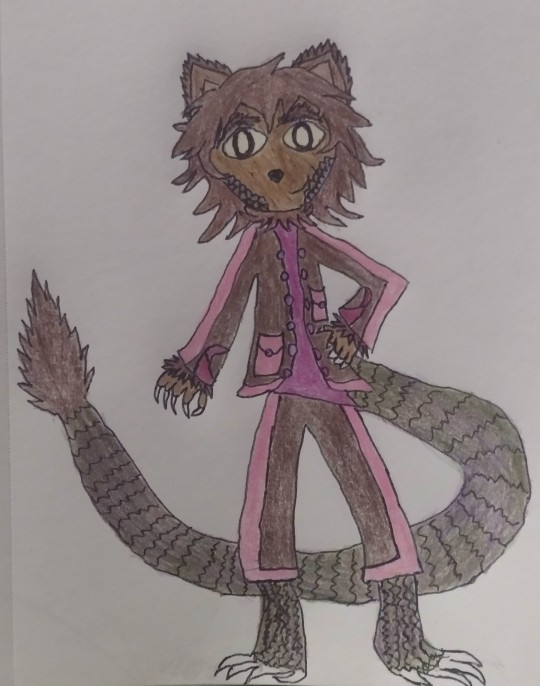
(family and friends now wish she would discover a hairbrush)
This is one of my OC’s from The SOS Chronicles, Silvie, the (feral) little Aguithan girl that Oliver and Silas befriend in book 2. When she’s not sneaking around on special missions and trying to help her friends save her planet from its evil overlord, she likes wearing bright colors since she never had the opportunity before. She especially likes pink because someone (probably Andy James, the only person with any fashion sense in this series on account of growing up with at least 4 sisters) told her it looked good on her. This pink and brown jacket is her favorite article of clothing and she wears it everywhere when she doesn’t need to be sneaky. The matching pants were just a bonus.
I’m also realizing that I think this is the first time I’ve drawn her in color??? So a little breakdown here: her fur is brown and it covers her face, arms and torso in varying lengths as you can see. Her legs and tail are scaled and iridescent, which is unfortunately very hard to show with colored pencils but I did my best by blending olive green and a few shades of purple together. I don’t know if you can tell, but her eyes are yellow.
#the sos chronicles#silvie the aguithan#silvie starfell#aguithans#not all aguithans look like this their fur colors vary just like cats!#their tail colors also vary#face scales slowly develop as an aguithan kitten matures#in the series silvie is about 10-12#I can't believe the first time I've ever drawn a color-coordinated outfit I did it for my feral kitten OC#the jacket is probably new here but it gets mended a lot#silvie would wear it until it turns to rags that's the autism for you#can't get over how stinkin cute she turned out look at this lil baby#when she has to sneak around she wears greens and browns and grays#she likes green a lot too it's probably her second favorite color#drawings#art#my art#sci fi#science fiction
8 notes
·
View notes
Text
i hear 1899 got cancelled. i know i'm supposed to feel sad or shocked or betrayed or whatever, but i feel none of those things. listen, i love my boy aneurin in all his glory and i want him to shine for several seasons to come like he did in the first (and only) one of this show but also i hated the ending 🙂
so now, with only one season, it's gonna be much easier to pretend those last 5 minutes never happened.
#love me or hate me#but i love period drama so much more than science fiction#i loved how the show felt like victorian science fiction#and got SO DISAPPOINTED when **spoiler alert** it turned out to be modern sci-fi at the end#that is all#i know it made sense but i still hated it 🙂#text
1 note
·
View note
Text
what i think REALLY works about dot and bubble is it plays with the genre conventions of doctor who itself. We've seen doctor lite episodes like this, we know how they work. There's person who needs to be saved who gets indirect help from the doctor, maybe they're flawed and learn a lesson at the end, maybe they're part of some flawed society that is just kind of set dressing or ends up being torn down at the end without examination. About halfway through the episode I was ready to brush this off as a fun but predictable classic rtd ep that wasn't really anything special. Then from the the betrayal of ricky September on its like watching a house of cards that has been built the entire episode without us noticing collapse into a perfect stack
“Oh well of course you could see them being racist the whole time” the thing is sometimes doctor who is just like that. RTD EPISODES have historically just been like that, either in that they are microagressions in themselves or have bigoted characters/worlds that go unexamined. And I think this episode performed an absolutely insane self aware slight of hand that relies on both you and the writers knowing that doctor who and sci fi in general has a racism problem. The ending recontextualizes things in the episode you may initially have brushed off as an unfortunate BBC or science fiction moment (all white cast, manifest destiny language) as symptomatic of larger societal issues, thus in turn recontextualizing missed moments of bigotry in the shows own history
#editing the post to include my reblog addition in case ppl see it in the tags#LIKE OH MY GOD. OH MY GOD#i think the end could have been. a little subtler with the specific script but seeing as people still dont get the racism and classism WHIL#IT WAS THAT HEAVY HANDED maybe its for the best#me when i saw they were all white in the early part: is this intentional commentary or a bbc casting moment#warlock wartalks#dw spoilers#doctor who
798 notes
·
View notes
Text
project aphrodite
rating: explicit
member: jungwon
premise: in a post-apocalyptic world, you and jungwon are excellent scientists and are at the relative top of the list of people who are ideal parents for the next generation of this dying world. it's now your job to repopulate this earth so you ask your co-worker to pretty please knock you up.
notes: sci-fi elements, dystopian au, scientist!reader, scientist!jungwon, fem-bodied reader, reader is referred to as a woman, dom!jungwon, breeding, impreg kink (like heavily), dirty talk, platonic (?) breeding, co-workers with benefits (?), idk this is kinda speculative fiction but also suspend your disbelief a bit lol
a/n: first of my 1k follower special! not quite sure what order i'm following here but i hope you stay for the ride nonetheless! enjoy!

it's a strange feeling.
in your line of work, 'strange' is hardly any cause for concern. as a biologist with a concentration in genetics, you've seen all the ways nature does its job. from the familiar concepts almost all people learn about in science class like the basic 'mom-meets-dad-equals-baby' to the eerie methods organisms in the deep sea evolve to survive.
you've learned about it all, pored over each punnett square, stressed over the formulas. so, this shouldn't be anything to worry about.
and yet, you're still worried.
"i mean...what did we expect?" jay speaks up from beside you, eyeing the phone in his hand.
"we're presently some of the world's most brilliant minds so...," he adds, locking his phone before hunching over his desk. to your ears, it sounds as if he's trying to convince himself rather than you.
you scan over the document flashed on your own laptop screen. the harsh fluorescent lights overhead buzz nonstop, going on and on, a background hum all of you in the bunker have grown used to. at this moment, it lulls you into a daydream, vision swimming as you repeat the words in your head.
all government personnel with a status level 7 and higher are recommended to partake in project aphrodite. those falling under level 10 are strictly required. participation at this level is compulsory.
common citizens with a status of 9 to 10 are also required to participate. ample compensation for those successful will be provided.
"you're a level 8. it's not as if you have to," you mutter, fingers digging into your temples.
jay snickers. "how many level 10 government personnel are there in this ruined world? a few hundred or so doctors, another few hundred scientists, even fewer world leaders. that's not taking into account the difference in sex. my information's not up to date but last time i checked, there is a hell of a lot more men than there are women. it's a shitshow waiting to happen."
you turn to meet jay's eyes, not meaning to convey any certain emotion, but the way jay's expression falls leads you to believe that you look way more upset than you're letting on.
"oh shit, yeah," jay curses. "you're a level 10. i forgot."
you sigh, tilting your head back against the headrest of your seat.
"i'm sure they'll release more regulation soon," you begin. "this is just the initial memo. with our world hanging in the balance as it is, no one's gonna let this devolve into some patriarchal anarchy, i hope."
"yeah, of course," you hear jay agree. "most of the proponents of project aphrodite are women, anyway, so i'm sure they'll take extra measures to keep you safe."
you sit up straight, looking at jay once more. "this is the world, huh?"
you and jay pause before sharing a quick chuckle.
"'go make babies, or else,'" you say in a mock radio announcer voice. jay lets out a laugh, his voice echoing off the empty office walls.
the two of you fall into silence, as if retreating to your respective thoughts. all that's in your mind at this moment is your current project, the very thing the few people more powerful than you had assigned for you to do: leading your team in stopping that godforsaken virus ravaging the outside. you've been making steady progress so far, but with the weight of this new responsibility, you're not sure if you could keep the momentum up.
you realize with a passing thought that most of the scientists on your team are level 9s and 10s.
"well," you begin before you could stop yourself. you're suddenly overcome with a feeling of suffocation, the office space seemingly too small and continuously growing even smaller.
"i hope you find someone you'd like to procreate with," you say lightly, pushing yourself off your chair. you quickly gather your things: folders and binders and other loose papers in your arms.
you catch jay looking at you, a pensive look on his face. you stop as you're grabbing your reusable coffee jug.
"no," you deadpan. "not me."
jay's eyes widen, as if realizing he'd said something without really saying anything.
"i—no, wait—i mean...," jay stutters, ears quickly turning red.
you smile, patting jay's shoulder reassuringly. "in case you were thinking about it."
jay's mouth opens and closes like a fish out of water and you can't help but laugh.
"these are desperate times, but i'm hoping it's not too desperate," you add. without waiting for a response, you turn towards the door, already making your way to it.
"besides, dr. isa lee seems more your type," you say over your shoulder one last time before pushing the door open and stepping out into the hallway.
---
"hey."
you look up from the microscope, tearing your attention away from the specimen you were examining. your eyes readjust to their normal focal length as a tall figure enters the lab, perfectly crisp white coat hanging off his broad shoulders, thin-wired spectacles resting on the bridge of his tall, straight nose. your lips feel strangely parched as he makes direct eye contact with you and you're left with no choice but to moisten them with your tongue.
"oh hi, dr. yang."
the other scientist chuckles, setting down a stack of papers on a desk in the corner. "i've been here for three weeks. please, call me jungwon."
you swallow. "right. jungwon."
dr. jungwon yang was a new import from the seoul bunker, having come to your own area's bunker merely a few weeks prior. he was immediately put under your supervision, an addition to your already elite team of biologists, geneticists, and virologists. off the bat, you could tell he was a man of many talents, coming up with unconventional solutions and arriving at answers quicker than anyone else.
his presence in your lab made your heart swell. in pride, adoration, or desire, you're not quite sure.
"uh, yesterday's results are in that binder over there, in case you want to go over them," you begin. jungwon walks over to your side of the long table, peering over the slide loaded into the microscope.
ignoring the way he brushes ever so slightly against you, you continue. "the director's dropping by later this afternoon, but i wouldn't be too bothered with that. he's just looking for someone to blame for the slow progress at this point. if only they could get us those materials we asked for..."
"have you read the memo?" jungwon asks abruptly, straightening up. he towers over you, his eyes downcast as he stares at your face.
"of course, you've read the memo," jungwon corrects himself, chuckling. "what i meant was...what do you think of it?"
"it's a government-issued memo, it hardly matters what i think," you respond, focusing back on your work in front of you, although all you do is stare blankly at the moving microorganisms, mind unfocused with how much of jungwon's perfume you can smell.
"it's your reproductive health that's on the line. i'm pretty sure your opinion counts for something," jungwon says with a pinch in between his eyebrows.
oh, a feminist. that's even hotter.
"okay, yeah. i appreciate the new guidelines they put out," you admit, looking back up at jungwon. "though it's the bare minimum, i'm glad they're letting us keep the autonomy of choosing who to...boink."
jungwon laughs at that.
"and free fertility drugs for anyone who wants or needs it. oh, also, thank god they didn't have the brilliant idea of putting a time limit on it. having read some crazy speculative fiction myself, the things people are willing to do in fiction are crazy. who's to say they can't do the same in real life?" you continue.
you don't notice the way jungwon's smirk grows as he listens.
"kind of makes the whole thing unsexy, don't you think?" jungwon cuts in, raising an eyebrow. you blink, unsure of what he's talking about.
"i'm surprised they're not monitoring us with cameras and hooking us up to EKGs and shit," he adds.
"oh," you say with a soft giggle, finally catching on. "i'm sure some people are into being watched."
"are you?" jungwon asks.
"am i what?" you answer.
"into being watched."
a pause.
you shake your head. "how about you?"
"oh no," jungwon says. "i prefer to keep what's mine for my eyes only."
"hm. possessive. that's kind of sexy," you mumble under your breath, a sudden surge of confidence coursing through you.
jungwon just stares at you, but you can see his pupils dance in amusement, taking in your whole face and all your features. you might have imagined it but he seemed to have peeked down at your chest for a second.
"do you think it's attractive for someone to be into lego-building? or at least, used to be into it. i'd give an arm and a leg for a complete lego set nowadays," jungwon asks, leaning against the table, and only now do you notice the veins running over the back of his hands.
you think about whether his arms are just as veiny.
"do you think it's a good trait to pass on an offspring? lego-building, i mean," he presses on.
"uh, yeah. good problem-solving skills," you answer, humoring his question.
jungwon nods. "do you think leadership skills are important?"
you smile, leaning against the cabinet opposite jungwon. you nudge his foot lightly. "i lead a team of scientists myself. of course, i think leadership skills are important."
"you and i both," jungwon agrees.
jungwon shifts, placing his hands in the pockets of his lab coat.
"how about dimples? do you think dimples are cute?" jungwon asks once more, one corner of his mouth upturned. a deep crease on his cheek appears.
a dimple.
"very," you admit.
"i see."
there's a silence that stretches over the two of you, and the weight of uncertainty is daunting as you stare at a spot on jungwon's tie. finally, after a few seconds, you heave a sigh, unable to take the tension any longer.
"this is the weirdest way anyone has ever flirted with me," you declare, looking up at jungwon through your lashes. he's grinning and you nearly shiver at how utterly attractive you're finding him at this moment.
"but it's effective," jungwon says. that was a statement, not a question.
you tilt your head to the side. "how do you know?"
"because you would have blown me off two minutes ago if it wasn't," jungwon reasons, crossing his arms. by doing this, he just made himself appear even wider than he is.
"always so calculated," you say, impressed.
you stretch your neck, easing your head from side to side, watching as jungwon fixes his gaze on the taut tendons of your neck. "are you also this precise in bed, dr. yang?"
jungwon approaches, a large hand resting on your hip. "that's for you to find out."
your breath hitches as you feel his thumb rub through the fabric of your skirt.
"later?" he asks.
"my place or yours?" you reply, fingertips grazing the front of his polo. you can just about feel the slope and ridges of his toned muscles.
"i'd like to be a gentleman, so mine," jungwon offers. "i'll walk you back to your room after."
"i was kind of hoping i wouldn't need to walk back after," you say, a hint of teasing in your voice.
"is that a challenge?" jungwon says, his other hand pressing firmly on your lower back. he pulls you to him and your hands involuntarily reach out towards his shoulders to steady yourself.
a few seconds pass before any of you speak again.
"that's for you to find out," you say.
---
"kind of weird, isn't it?" jungwon asks, panting against your neck.
your back is pressed firmly against one wall of his sleeping quarters, a wide, loft-like room, similar to yours. a luxury offered only to level 10 government personnel, the room gives its occupants enough space and enough privacy.
and boy, did you need privacy.
"what's weird?" you say breathily, fingers threading through jungwon's hair as he kisses down the column of your neck. his fingers nimbly undo the buttons of your blouse and you whimper when you feel him lick at the valley between your breasts.
"coming up to coworkers or friends then asking them to reproduce with you," jungwon responds, tugging your blouse off of your shoulders.
(you both held enough respect for the institution that employed you both, so your work lab coats were neatly thrown over the back of jungwon's couch before anything got too frisky.)
"see, it's the way you say it that makes it weird," you giggle. you pull jungwon back up to your face, kissing him fervently, tongue licking into his mouth.
"oh yeah? how would you say it?" jungwon challenges as he pulls away slightly, his nose grazing your cheek. he licks a stripe on the underside of your jaw.
"please, jungwon," you whimper, playing up the whine in your voice just a little bit. "need you to knock me up. make me pregnant, please."
jungwon grunts in your ear, reaching behind you to rip the zipper of your skirt down. you let the fabric fall to the floor, stepping out of it quickly, revealing the matching red lace panties you had in tandem with your bra.
"yeah? want me to cum inside you so many times that there won't even be the tiniest chance that you're not pregnant?" jungwon says lowly, kneading one of your boobs in his hands.
you nod, hooking a leg around jungwon's hip, pushing your core right up against the bulge in his pants.
"yes," you breathe out, dragging your clothed pussy over his straining cock. "let's be good citizens and have a whole bunch of kids, yeah?"
jungwon chuckles, hands hurriedly working on his belt. you take this time to kiss up his neck, still rutting against him, desperate for any contact.
"come here," jungwon says through gritted teeth as his pants and boxers fall to the floor. he kicks them off unceremoniously, yanking you towards the couch. your eyes briefly catch the flash of white that were your lab coats.
the two of you fall onto the cushiony surface, with jungwon sitting up and you falling a little less gracefully on him. the two of you laugh as you adjust yourself, righting your posture so you could look at jungwon.
"take this off," jungwon commands, pulling at your panties. you swing off jungwon for a moment, pulling off the garment in record time. you reposition yourself over jungwon, his cock standing tall, hard, and painfully red.
"come on, show me how bad you want those kids," jungwon teases, tucking your hair behind your ear.
you roll your eyes. "you gotta help with the diapers."
a second later, you sink down on jungwon, moaning wantonly at how much he stretches you out, filling you up effortlessly. jungwon throws his head back, his bottom lip pinched between his teeth.
"i'll quit my fucking job at the lab if this is how good it feels to make babies with you," jungwon groans, his fingers digging into the flesh of your hips.
you whimper at his words, rocking back and forth on his lap. you angle your hips a certain way, the tip of his cock kissing at just the perfect spot inside you. you shudder, repeating your movement.
"god, you feel amazing," jungwon praises. "so warm, so tight."
"yeah," you respond. you're gliding up and down his cock, swiveling your hips as fast as you can. you clench down around him, the thought of jungwon cumming inside you your only motivation.
"filling me up so good," you add, watching as jungwon screws his eyes shut, neck shiny with sweat.
you move forward, attaching your lips just below jungwon's ear. you suckle on the salty skin, running your tongue over the spot, savoring the way jungwon lets a moan rip out of him.
"gotta let the whole bunker know this one's mine," you whisper as you let up on jungwon's neck. a faint red spot is left in the wake of your lips on his skin.
in a blink of an eye, your whole world tumbles upside down, jungwon's hands forcing you down on the couch by your waist. in a daze, you realize that jungwon has you pinned under him, his eyes wild with a hungry look in them. he pushes your legs right up against your chest, lining himself up with your entrance.
"the moment you start showing, no one in this goddamn bunker will have a single doubt who gave you that baby," jungwon counters, thrusting into you. he gives you no time to adjust, picking up where you left off.
you cry out, trying to anchor yourself on anything your hands can find. eventually, you find purchase in jungwon's shoulders. he feels your nails digging in, and he mutters a soft 'fuck', speeding up his movements, the wet sounds of his skin slapping against yours so incredibly obscene in the confined space of his room.
"give it to me, please," you say, meeting jungwon's eyes as he continues to fuck into you. his forehead is creased, a look of concentration washing over his face.
"cum inside, fill me up as many times as you want, fuck it deep in me," you continue, cradling jungwon's face in your hands, the tender gesture a contrast to how rough he's bein.
"god," jungwon groans, voice breaking at the end as he speeds up, but then he halts abruptly, his mouth hanging open in a silent moan. you feel him twitch inside you and you gasp, clenching down as hard as you can.
"fuck, yes, milk it all out," jungwon says. he starts to thrust up into you again, watching as his cock is slowly coated with his cum spreading all over your cushy walls.
you whine, your fingers finding their way down to your cunt, your middle and ring finger pressing onto your clit. you rub at it ferociously, the idea of jungwon's sticky release inside of you turning you on impossibly.
"i'm getting hard again, jesus christ," jungwon complains but his movements don't cease. he's shaking from the overstimulation but he wraps his arms around you, pulling your limp form up against him.
"rub that pretty pussy for me, babe," jungwon requests, thrusting up into you shallowly.
"make yourself cum while i fill you up for a second time."
---
"so?"
you jump a little at the sudden intrusion. you look up at jungwon through both of your reflections in your bathroom mirror. three pregnancy tests lie in a neat line on the edge of the sink.
"i just started the timer, jungwon," you reply with a laugh. jungwon turns you around to face him, kissing you briefly.
"hm," you say, looking up at jungwon questioningly. "you never kiss me unless you want something."
"well," jungwon begins, hands slipping under your sweater. "we can always kill time while we wait for the results."
you shake your head, but you're already pressing yourself up against jungwon. "you're insatiable, dr. yang."
jungwon winks at you, undoing your bra under your shirt. "you know it."
"plus, you just look too good in this damn lab coat."
4K notes
·
View notes
Text
Book recs: Queer science fiction, part 1
There is a lot of queer sf out there, and I read a lot of sf. When I started working on this list, I quickly realized it was impossible to include all that I've read and enjoyed in one single rec post. Thus, this is the first of so far three queer sci-fi book rec posts.
A note: queer here does not necessarily mean "guarantee of an f/f or m/m ship with a happy ending", but rather simply a significant presence of queerness. Some of the books feature no romance but has a same gender attracted/trans/a-spectrum lead, or features an m/f relationship with bisexual, trans or aro/ace characters, or simply features a world-building which is heavily queer inclusive in ways that don't always compare to our own ideas of sexuality and gender. I have however disqualified works where the only queer presence is along the lines of "gay best friend" or a blink and you'll miss it confirmation that never comes up again.

Previous book rec posts:
Really cool fantasy worldbuilding, really cool sci-fi worldbuilding, dark sapphic romances, mermaid books, vampire books, many worlds: portal fantasies, many worlds: alternate timelines, robots and artificial intelligences, post- and transhumanism, alien intelligences
For more details on the books, continue under the readmore. Titles marked with * are my personal favorites. And as always, feel free to share your own recs in the notes!

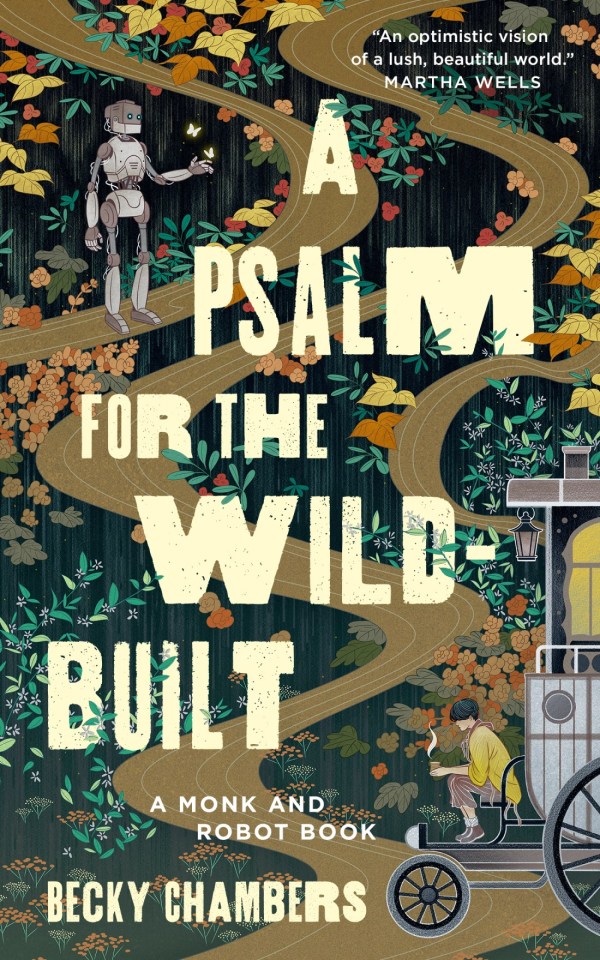
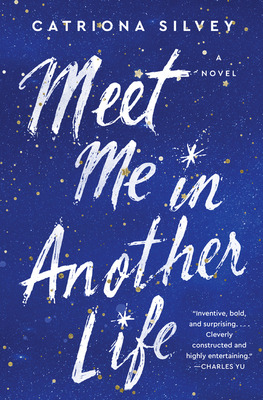
The Light Brigade by Kameron Hurley*
Dietz is a soldier in the war between Earth and Mars - to travel to the battle front, she and her fellow soldiers are broken down into light to be able to quickly travel across space. But something keeps going wrong with Dietz's travels; her memories don't match up with the mission briefs, as she experiences time itself turning in on itself. Is she going mad? Or are the things she's learning skipping through time the truth - and the war that's stealing her life the lie? A mindfuck of a book that's scathing in its critique of fascism and war. Features a sapphic lead but no romance.
A Psalm for the Wild-Built (Monk and Robot duology) by Becky Chambers
Novella. Long ago, robots, upon gaining sentience, simply laid down their work and walked into the wilderness. Long after, a tea monk looking for purpose follows after them into the wilds, where they come across one of the robots seeking its own sort of answers. While not plotless, this story focuses more on character and vibes over plot. Also has a nonbinary main character and features conversations on gender between human and robot.
Meet Me In Another Life by Catriona Silvey*
Thora and Santi are strangers, brought together by a coincidence and torn apart just as abruptly when tragedy strikes. But this is neither the first nor the last time they meet - again and again they encounter each other, as friends, lovers, enemies, family, every time recognizing in each other a familiarity no one else carries. But with every new life, a mysterious danger grows ever closer, forcing them to find out the truth of their connection. This is a puzzle-box of a story that goes some entirely unexpected places in a very wild ride, featuring a bisexual co-lead.
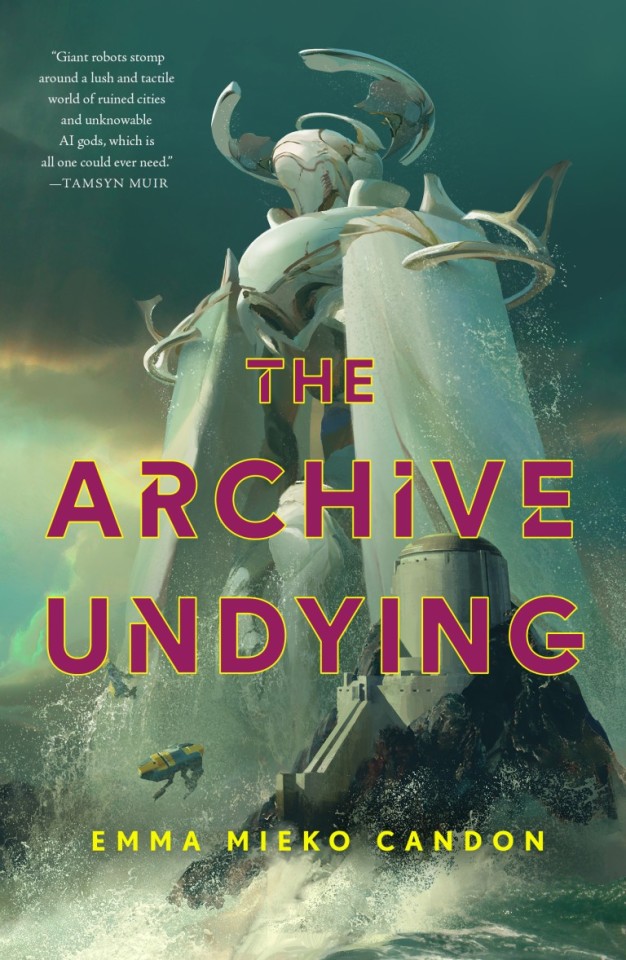
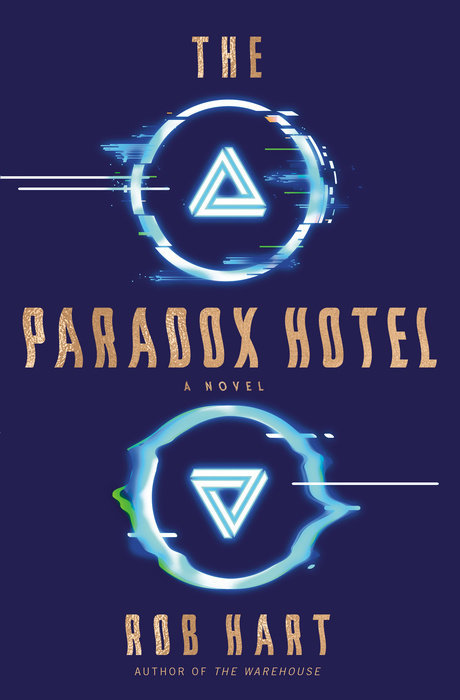
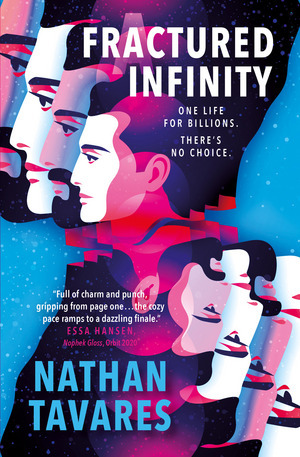
The Archive Undying (The Downworld Sequence) by Emma Mieko Candon
In a world where AI gods sometimes lose their minds and take entire populations down with them, Sunai was the only survivor when his god went down. In the 17 years since, he has wandered on his own, unable to either die or age, drowning his sorrows in drink and men. But his attempts to flee his past comes to a stop as he is forced back into the struggle between man and machine. Featuring some pretty wild world building and narrative techniques, this book will definitely confuse you, but it is worth the experience.
The Paradox Hotel by Rob Hart
January Cole works security at the Paradox Hotel, last stop for tourists heading for the timeport, which allows them to travel to and witness any moment in time. But years of proximity to the timeport has left its damage on January, making her unstuck in time, letting her relive memories of her dead lover even as her sanity slips away bit by bit. As she starts witnessing proof of a horrible crime in the hotel that no one else can see, January must race against her own mind, a killer, and time itself to solve it before it's too late.
A Fractured Infinity by Nathan Tavares
Hayes Figueiredo is a struggling film-maker who wants to finish his documentary, whose life gets turned upside down when handsome physicist Yusuf Hassan enters his life, claiming an alternate version of him is a great inventor who’s sent a mysterious device to their universe. As Hayes gets drawn deeper into the conspiracy - and his feelings for Yusuf intensify - he has to decide just how far he’s prepared to go to win the life and the love he wants. Featuring a very gay and very morally dubious lead, this is a creative and strange read.


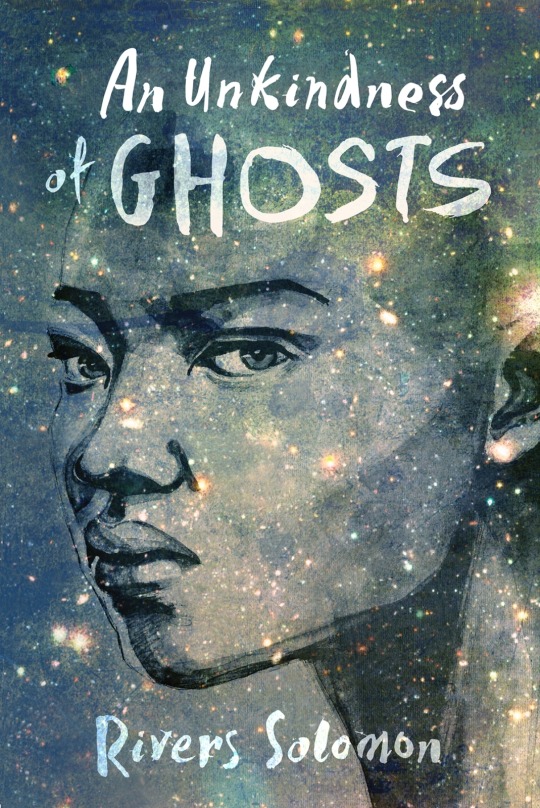
Bridge by Lauren Beukes
When she was little, Bridge and her mother Jo used to play a game - one where they traveled to other worlds, inhabiting the bodies of their other selves. Now Jo is dead, and as Bridge is cleaning out her apartment she finds a strange device: a dreamworm, the very thing that supposedly makes inter-dimensional travel possible. Suddenly faced with the possibility that multiverse travel is real, Bridge is struck by a different question: could her mother still be alive? Scifi spiced with a healthy dose of body horror and some absolutely wild twists, Bridge also features a bisexual lead (however this is a blink and you’ll miss it moment) and a nonbinary co-narrator.
The Long Way to a Small, Angry Planet (Wayfarers series) by Becky Chambers
Rosemary Harper just got a job on the motley crew of the Wayfarer, a spaceship that works with tunneling new wormholes through space. With a past she wants to leave behind, Rosemary is happy to travel the far reaches of the universe with the chaotic crew, but when they land the job of a life time, things suddenly get a lot more dangerous. A bit of a tumblr classic in its day, this is a cozy space opera with an episodic feel and vividly realized characters and cultures. While pretty light on romance and focusing found family, there is a main f/f relationship.
An Unkindness of Ghosts by Rivers Solomon
Life on the lower decks of the generation ship HSS Matilda is hard for Aster, an outcast even among outcasts, trying to survive in a system not dissimilar to the old antebellum South. The ship's leaders have imposed harsh restrictions on their darker skinned people, using them as an oppressed work force as they travel toward their supposed Promised Land. But as Aster finds a link between the death of the ship's sovereign and the suicide of her own mother, she realizes there may be a way off the ship.
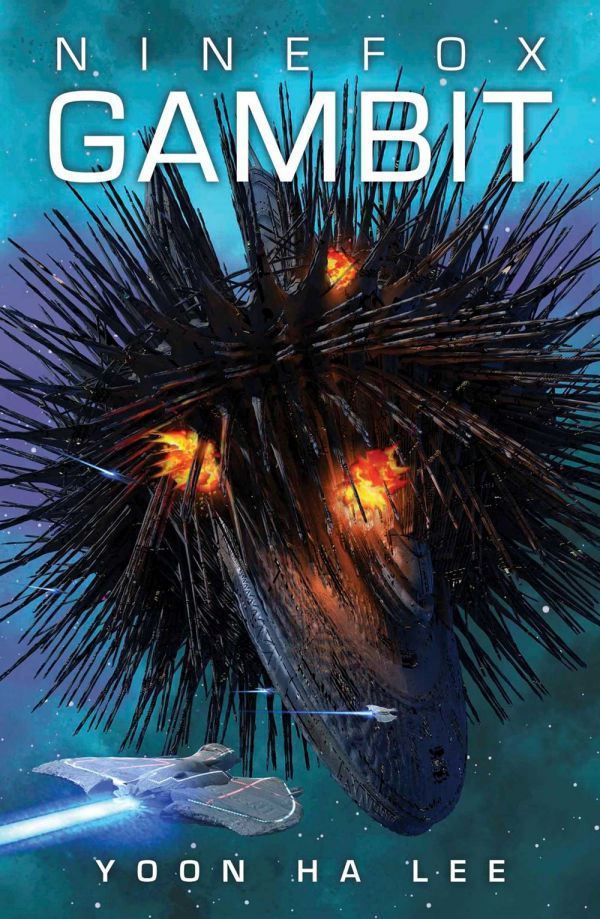
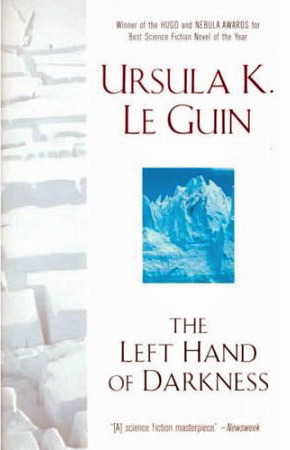
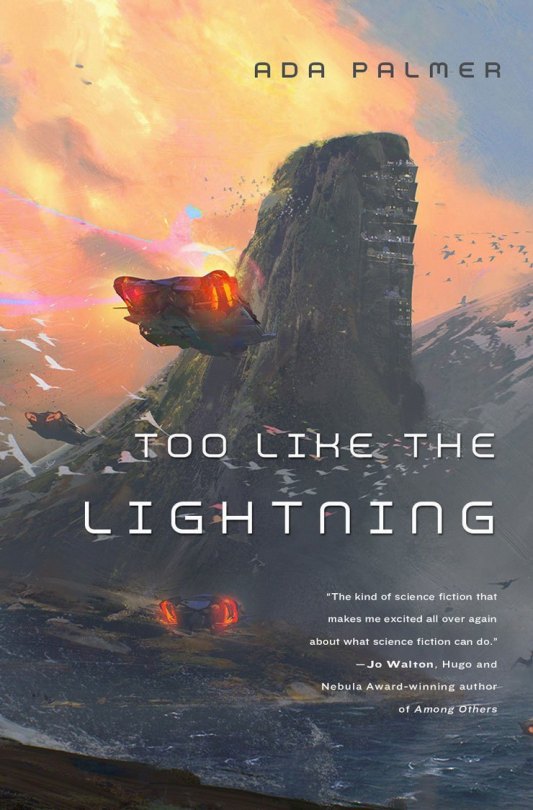
Ninefox Gambit (The Machineries of Empire trilogy) by Yoon Ha Lee*
Military space opera where belief and culture shape the laws of reality, causing all kinds of atrocities as empires do everything in their power to force as many people as possible to conform to their way of life to strengthen their technology and weapons. It’s also very queer, with gay, lesbian and trans major characters, albeit little to no romance.
The Left Hand of Darkness (Hainish Cycle) by Ursula K. Le Guin
1969 classic. Genly Ai is an emissary sent to the planet of Winter, meant to help facilitate Winter's inclusion in a growing intergalactic civilization. But he's unprepared for Winter's citizens, who spend much of their time genderless or switching between genders, making for a culture wildly different from that Genly is used to.
Too Like the Lightning (Terra Ignota series) by Ada Palmer*
Centuries in the future, humanity has deliberatly engineered society to be as utopian as possible, politically, socially, sexually, religiously. Written in an enlightenment style and featuring questions of human nature and whether it’s possible to change it, and what price we’re prepared to pay for peace, this book is simultaneously very heavy and very funny, and written in a very unique style. While still human, the society presented often feels starkly alien.
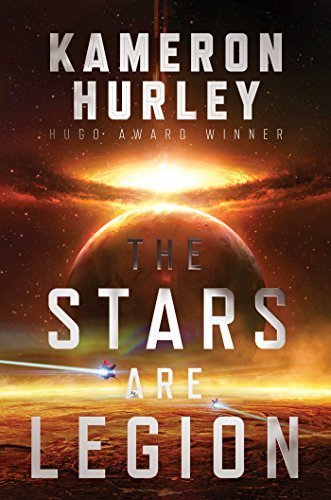
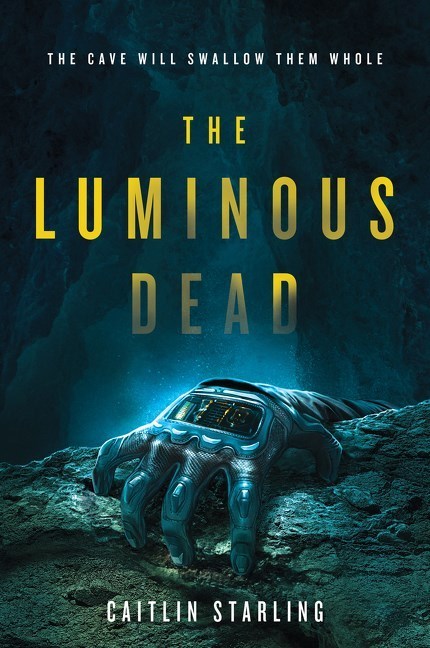
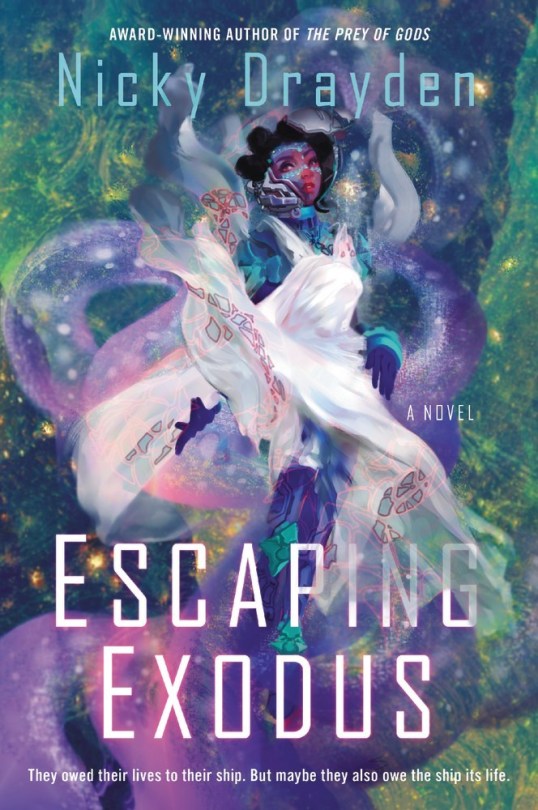
The Stars Are Legion by Kameron Hurley
This book fucked me up when I read it. It’s weird, it’s gross, there’s So Much Viscera, there are literally no men, it has living spaceships and biotech but in the most horrific way imaginable. Had I to categorize it I would call it grimdark military sf. It’s an experience but not necessarily a pleasant one.
The Luminous Dead by Caitlin Starling*
Possibly one of the most unsettling books I’ve ever read, and definitely the most claustrophobic. Gyre, a caver on an alien planet, ventures into the dark and dangerous underground, guided only by a woman who has no compunctions on using and manipulating Gyre as she sees fit to obtain her secretive goals down in the caves.
Escaping Exodus (Escaping Exodus series) by Nicky Drayden
While my feelings on Escaping Exodus were mixed, it cannot be denied that the dynamic between the two leads and the way they go from childhood best friends to enemies on different sides of a class and power struggle is very delicious. It also features some really cool worldbuilding of living, alien generation spaceships and the human culture that has developed inside them.

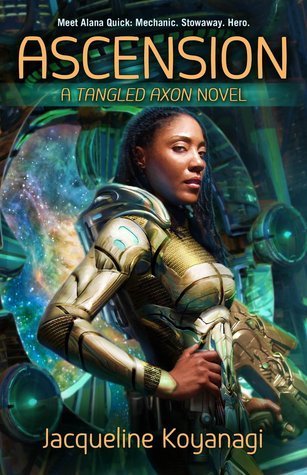
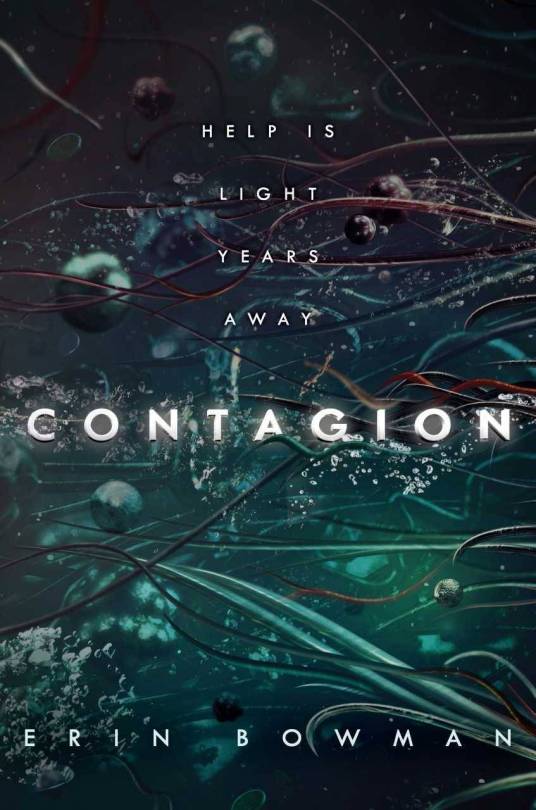
The Doors of Eden by Adrian Tchaikovsky*
The Doors of Eden is something of an experiment in speculative biology, featuring versions of Earth in which various different species were the one to rise to sentience, from dinosaurs to neanderthals. Now, something is threatening the existence of all timelines, dragging multiple different people and species into the struggle, among those a pair of cryptid hunting girlfriends and a transgender scientist.
Ascension by Jacqueline Koyanagi
Ascension follows Alana Quick, an expert Sky Surgeon who stows away on a spaceship in hopes of landing herself a job. But the ship and its crew are in deeper waters than she expected, facing threats emerging from a whole other universe, all of them searching for the same person: Alana’s spiritually enlightened sister. Undeniably a bit of an odd read, Ascension is also very creative and features polyamorous lesbian relationship.
Contagion (Contagion duology) by Erin Bowman*
Young adult. After receiving an SOS, a small crew is sent on a standard search-and-rescue mission. But what they find are not survivors awaiting help, but an abandoned site, full of dead bodies and crawling with something... monstrous. No romance, but features one sapphic co-lead and one who can easily be read as demisexual (however this doesn't show up until book two, which has more romance).
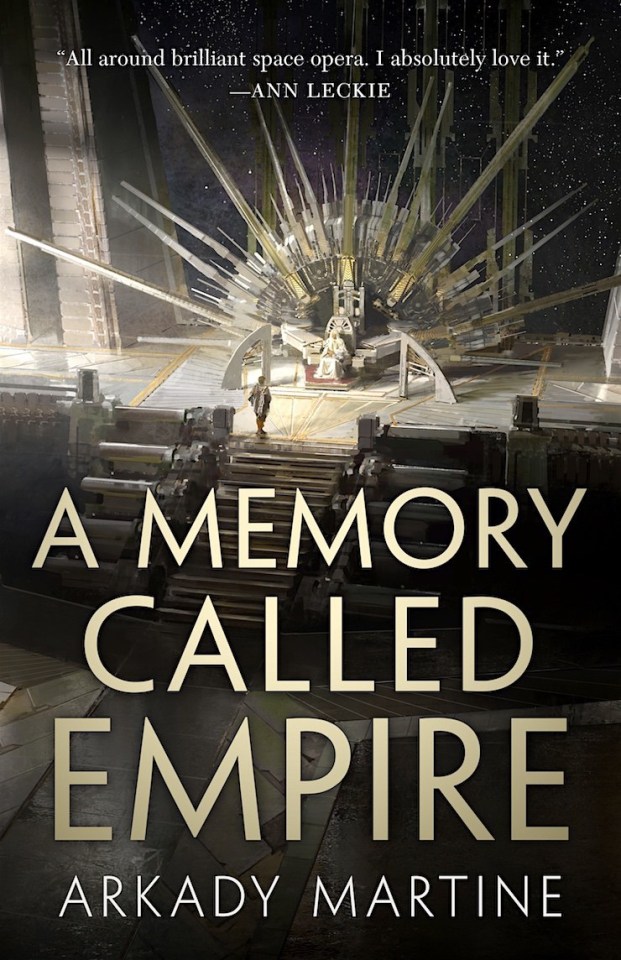

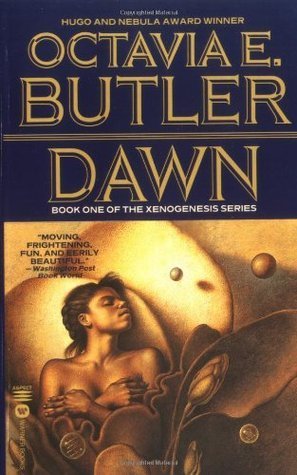
A Memory Called Empire (Texicalaan duology) by Arkady Martine
Mahit Dzmare is an ambassador sent to the center of the multi-system Teixcalaanli Empire, where she discovers that her predecessor has died. Trying to protect her home, an independent mining station, from being taken over by the empire, Mahit struggles to find out the truth of her predecessor's death while carrying the voice of his ghost in her head, guiding her as best he can. Light on the romance but does feature a sapphic relationship.
The Outside (The Outside trilogy) by Ada Hoffman*
AKA the book the put me in an existenial crisis. Souls are real, and they are used to feed AI gods in this lovecraftian inspired scifi where reality is warped and artifical gods stand against real, unfathomable ones. Autistic scientist Yasira is accused of heresy and, to save her eternal soul, is recruited by post-human cybernetic ‘angels’ to help hunt down her own former mentor, who is threatening to tear reality itself apart. Sapphic main character.
Dawn (Xenogenesis trilogy) by Octavia E. Butler*
After a devestating war leaves humanity on the brink of extinction, survivor Lilith finds herself waking up naked and alone in a strange room. She’s been rescued by the Oankali, who have arrived just in time to save the human race. But there’s a price to survival, and it might be humanity itself. Absolutely fucked up I love it I once had to drop the book mid read to stare at the ceiling and exclaim in horror at what was going on. Queer in the sense that the Oankali doesn't follow human ideas of gender and relationships, which is mirrored in their romantic relationships with humans. It is, however, pretty dark, with examinations of agency and consent, so enter with caution.
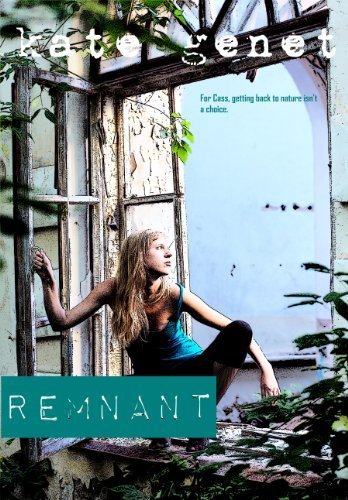
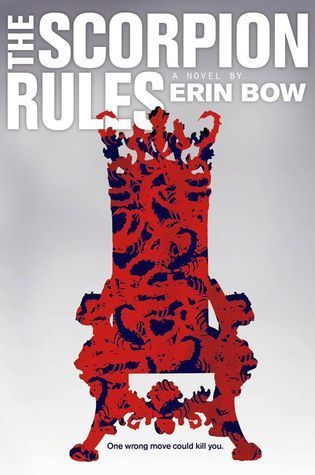
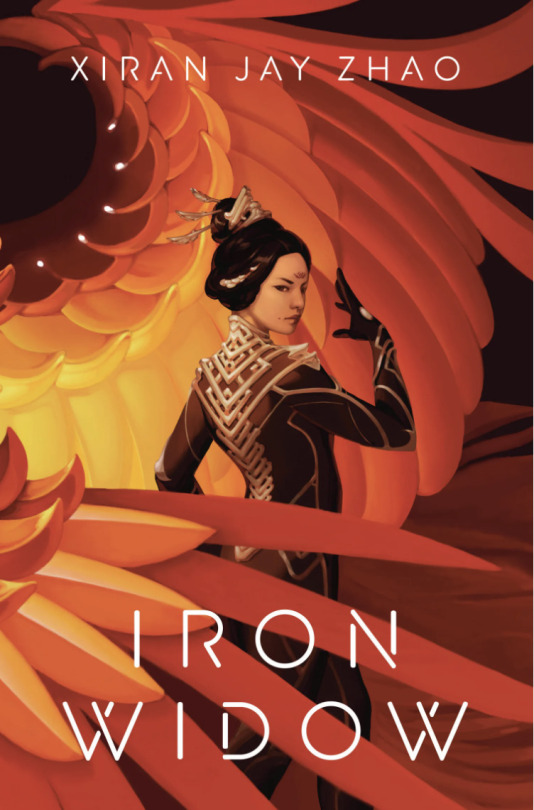
Remnant by Kate Genet
One day, Cass wakes up and finds everyone else is gone. Not dead, just gone, leaving her in a world which nature starts taking back with a dangerous, unnatural speed. But as she tries to survive this new normal, Cass realizes she may not be alone after all - but who else is out there, and are they a threat?
The Scorpion Rules (Prisoners of Peace duology) by Erin Bow*
Young Adult. Featuring a dystopian future in which an AI forcibly keeps world peace by holding the children of world leaders hostage. If anyone attempts to start a war, their child will be executed. Greta is one of these children, kept in a school with others like her. But things start to change one day when a new, less obedient hostage arrives. A unique, slowburn take on the YA dystopian craze, also featuring a bisexual love triangle.
Iron Widow (Iron Widow series) by Xiran Jay Zhao
Young adult. Zetian is a citizen of Huaxia, where mecha aliens are constantly trying to breach the Great Wall. To keep them at bay, couples of men and women pilot so called Chrysalises, giant transforming robots. But the pilots are not equal - the women almost always die, sucked dry by their co-pilots. When Zetian sets herself up to become a concubine-pilot, she does so with the plan to assassinate the male pilot who caused her sister's death. Features a polyamorous main relationship.
Bonus AKA I haven't read these yet but they seem really cool:
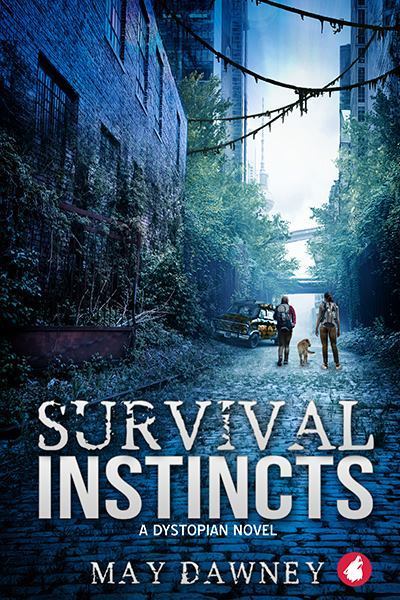
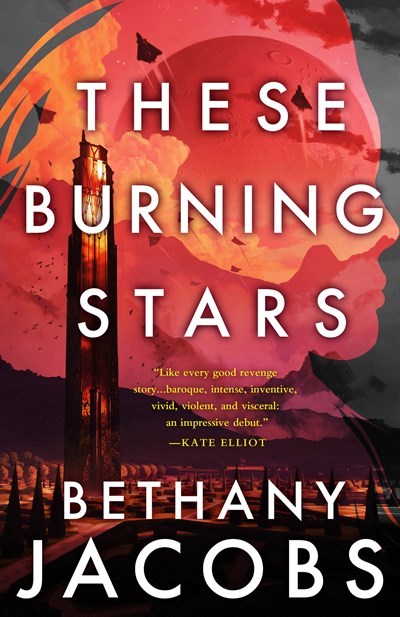
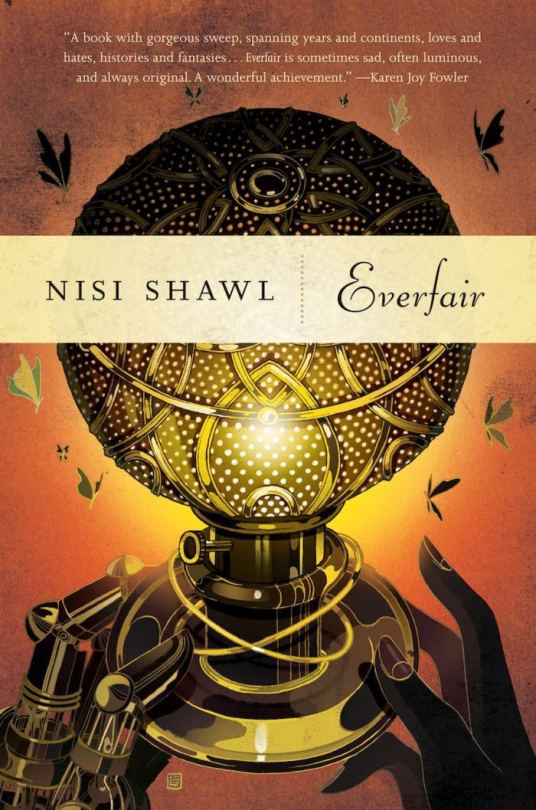
Survival Instincts by May Dawney
Lynn Tanner has been surviving the post-apocalypse alone with only her dog for a long time, trusting no one. But when she's forced to travel the dangerous remains of New York City alongside another woman, her priorities are challenged. Is staying alone really the best way to stay alive?
These Burning Stars by Bethany Jacobs
When con-artist Jun Ironway gets her hands on possible proof of the powerful Nightfoot family, controllers of interplanetary travel, committing genocide, she has in her hands a chance of taking them and their monopoly down. But the family and their allies won't go down easily, and sends two brutal clerics to stop her.
Everfair by Nisi Shawl
A neo-victorian alternate history, in which a part of Congo was kept safe from colonisation, becoming Everfair, a safe haven for both the people of Congo and former slaves returning from America. Here they must struggle to keep this home safe for them all.
#nella talks books#the light brigade#a psalm for the wild built#meet me in another life#the archive undying#the paradox hotel#fracture infinity#bridge#the long way to a small angry planet#an unkindness of ghosts#ninefox gambit#the left hand of darkness#terra ignota#the stars are legion#the luminous dead#escaping exodus#the doors of eden#the outside#xenogenesis#remnant#the scorpion rules#iron widow#survival instincts#these burning stars#everfair
798 notes
·
View notes
Text
It's Black History Month
(Over here in the US of A) So here are some podcasts to check out.
Absolutely no Adventures - a fantasy (un)adventure story that follows Sig, the owner of Signature Eats bakery, as he aggressively avoids becoming embroiled in any daring quests or chosen one shenanigans even though the universe really seems to want him to do just that. This is a story about cutting Joseph Campbell’s Hero’s Journey off at the knees to chill with friends and staying far, far away from the slightest whiff of adventure. And also baking. This is also a story about baking.
Afflicted - Lovecraft Country meets True Blood in this new series from award-winning producers Tonia Ransom and Jen Zink. In season one, a small East Texas town suffers supernatural disasters caused by a demonic book bound in human flesh…and only hoodoo can save the town from its affliction.
Apollyon - In the early 22nd century, the Apollyon virus wiped out 75% of the world’s population, and now most of the world is governed by the International Conglomerate of Research Scientists. Dr. Theo Ramsey is an ICRS research scientist who may have just discovered an effective vaccine for Apollyon, but the stakes to get the vaccine to the public are higher than she ever imagined.
Between Heartbeats - Tan immersive Urban Fantasy about the hurt, the powerful, and their growth within a broken world. We follow Sundiata, a guilt-ridden time manipulator with a knack for unemployment, and Nadia, a moralistic telepath determined not to lose control, as they balance frayed mental health against an unsympathetic police state. But when a malevolent presence rears is head, their neuroses become the least of their problems. Can our heroes make the most of their abilities before the option is taken from them?
Fan Wars: The Empire Claps Back - Two passionate Star Wars fans on opposite sides of the Last Jedi debate argue via Skype after their favorite forum closes down. If you love Star Wars (or call yourself a proud member of any fandom), you’ll love this romantic comedy told via
Harlem Queen - a Black historical fiction audio drama based on the life and times of Black, woman, "gangster" Madame Stephanie St. Clair during the Harlem Renaissance.
His Royal Fakin' Highness - What if Ophelia helped Hamlet get his throne back? This modern day, romantic comedy re-imagining of Shakespeare's Hamlet asks just that. As they stage an engagement in the wake of the king's death, these childhood frenemies must decide between duty and love.
InCo (This one's mine :D) - A Sci-Fi story about a disgruntled information seller, a mysterious space boy, and an android doing her best.
Janus Descending - a limited series, science fiction/horror audio drama podcast, follows the arrival of two xenoarcheologists on a small world orbiting a binary star. But what starts off as an expedition to survey the planet and the remains of a lost alien civilization, turns into a monstrous game of cat and mouse, as the two scientists are left to face the creatures that killed the planet in the first place.
Lady Lucy - Lady Lucy is an audio drama inspired by Shakespeare's "Dark Lady" Sonnets, 127-154. Between running her brothel, fighting the Church, murdering her friends' abusive husbands, and pretending to be a poet, the last thing Lucy needed back in 1586 was a surprise visit from her former flame... Will Shakespeare.
Liars and Leeches - Tonya Wright felt it all after the tragic murders of her sister and brother-in-law in a random act of gun violence. Struggling to travel outside of her home, she now lives constantly on edge about perceived threats that seem to surround her.
Nightlight - Multi-award winning horror podcast featuring creepy stories with full audio production written by Black writers and performed by Black actors. So scary it’ll make you want to leave your night light on.
Null /Void - a science fiction audio drama about a young woman, Piper Lee, whose life is saved by a mysterious voice named Adelaide. Piper soon uncovers a malicious plot by a monopoly of a tech company and must work with her friends and an unusual ally to help foil their deadly plot.
Out of Ashes - (currently remastering season 1) Follow a group of survivors as they navigate the ruins of modern civilization and battle against demons, ghosts, monsters and the looming threat of extinction from an ancient power.
Small Victories - A recently recovered drug addict tries to start her new lease on life, too bad life has it out for her. This dramatic comedy follows Marisol through the ups and downs of her life.
The Courtship of Mona Mae - In the 1870s, pioneers Mona Mae Christophe and Zekial Montgomery search the American West for Mona Mae's mother, Clara. Mona must recall a past, long forgotten in order to survive, so that she can find her mother, love and create a way of life for herself.
Vega a Sci-Fi Adventure Podcast - In a fantasy futuristic world, Vega Rex is employed by her government to kill off the world's worst criminals. She's never met a criminal she couldn't catch…until now. Join Vega as she journeys through a world of bumbling apprentices, powerful technogods, and her biggest challenge yet. Hosted by Ivuoma Hall.
Witchever Path - is an anthology series where your decisions effect the story. Our stories are based in America’s NorthEast, featuring characters finding themselves in the thick of the unknown while tackling issues like queer identity, gender, race, and spirituality. Stories often focus on the communities not typically seen in stories taking place in New England, and giving voice to the perspectives of those communities while uniting under some universal themes. And the supernatural happens. A lot.
(All descriptions were taken from websites)
If you want to find more and there are way more there's a directory :D
584 notes
·
View notes
Text
Which Star Trek series should you start with?
The Original Series: Advantages: + The one that started it all + Has some sophisticated and socially conscious science fiction that has held up exceptionally well + The lead characters all have really good chemistry and fun to see play off of one another + It's what most people probably think of when you say Star Trek (together with TNG) Disadvantages: - It can feel very dated and kind of sexist, particularly in its treatment of women - The sci-fi and social commentary may have held up, but damn it, the special effects really haven't - When TOS is bad, it's really, really bad.
The Animated Series: Advantages: + Basically just more TOS. Disadvantages: - Basically just more TOS, but substituting extremely cheap animation for bad special effects
The Next Generation: Advantages: + Probably the most popular one at this point + The crew is full of interesting characters and they're fun to spend time with + Just really smart people solving Space Mysteries + Socialist space utopia + Geordi-And-Data! + Lots of cool sci-fi concepts and social commentary + It's what most people probably think of when you say Star Trek (together with TOS) Disadvantages: - Although not in the same way as TOS, it can feel dated at times, particularly in terms of its treatment of women and it's near complete refusal to acknowledge queerness - Without wanting to bias viewer opinion, the first season is widely considered to be pretty bad - The series makes no bones about the fact that the socialist space utopia is better than every other society that has ever existed and will reiterate this point over and over again
Deep Space Nine: Advantages: + The most popular Trek series on Tumblr + Has a complete story arc, as well as arcs for all of its characters, including the extremely minor ones + Plain, simple, Garak. The humble tailor. + Garashir, if you're into that + Seriously has a really sophisticated treatment of things like post-colonial politics, anthropology, worldbuilding, and the horrors of warfare + Just the characters in general + Is the only Star Trek prior to the 2010s to even look meaningfully at queer representation Disadvantages: - Has an absolutely massive inferiority complex with respect to TNG and this drives a few poor writing decisions that seemingly exist just to poke the Socialist Space Utopia in its eye - Introduces a space religion and then just slowly turns it into Christianity with the numbers filed off - Seems to think that sexual harassment is just a quirky eccentricity - There's no women in its writers' room, and frankly it shows
Voyager: Advantages: + Probably the clearest instance of found family in space + Lots of really good episodes + Lots of fun new characters + Strong female role models + "Set a course...for home." Disadvantages: - Continuity? I never knew her! - Probably about 90% of Trek's reputation for technobabble comes from this one series - Even less queerness than TNG. - Only like...3 characters actually get arcs. - The first few seasons lean very hard into bullshit fake "Native American" spiritualism with one of the characters - How do these guys have warp drive but can't find any water?
Enterprise: Advantages: + Chronologically the first series + 90% less technobabble + The only series to plausibly frame our heroes as astronauts...on some kind of...star trek. + Still has probably the best production values of any series + Makes alien cultures of the week feel somehow richer and deeper than other series + Faith of the Heart is good, fuck you. Disadvantages: - Oh my god, the decon scenes - Seriously, if you've ever wondered what a "sexy" series written by a 14 year old boy who's only ever seen a bit of scrambled softcore porn on late-night cable would be like, this is the show for you - Somehow feels more sexist and racist than the show from the '60s - Seriously, the POC characters mostly exist to fill seats on the bridge; the women constantly have to undress themselves - Hellooooo, Bush II-era political analogies - Scott Bakula is a good actor but you wouldn't know it from this series - In season 3, they add a tambourine beat to Faith of the Heart and ruin it
Discovery: Advantages: + Noticed the lack of queer characters in the first 50 years of Star Trek canon and decided to make up for lost time + Seriously, the "Bury Your Gays" tally for this series is like...negative two + Just incredible representation in general + Some really good science fiction plots, particularly in later series + Some really fun, memorable characters + It's still running, so it has an active fandom on Tumblr Disadvantages: - Makes Elon Musk out to be one of the great visionary geniuses of history - Not really representative of Star Trek as a whole - The series swerves wildly in tone because of constant, behind-the-scenes churn in the writers' room - Offputtingly grimdark first season - Let's be honest, none of the season-long arcs have actually had satisfying conclusions - Half the cast feels like it's just there for exposition and to be killed for cheap drama
Picard: Advantages: + Has the best dramatic acting of any Star Trek series by a fair margin + Has the best musical score of any Star Trek series + Introduces a whole crew of fascinating new characters + Introduces all kinds of fascinating transhumanist concepts + AGNES. JURATI. Disadvantages: - You know all of those fascinating new characters that I mentioned? Yeah, it unceremoniously gets rid of all of them to bring back the old TNG gang. - You know that all of those fascinating transhumanist concepts that I mentioned? Yeah, it gets rid of those too so that to give us some generic action - Oh my god, someone teach the set designers to operate a fucking light switch - Grimdark - Nossssstalgia - Each season is basically unrelated to every other season - Depends so heavily on TNG that its final season is basically unwatchable if you haven't already seen a 30-year-old TV series
Lower Decks: Advantages: + It has probably the most efficient storytelling that I've ever seen; seriously, it's incredible how much it can fit into a half hour episode + It has a bunch of delightful, archetypical characters you get to know and love + You like hanging out with these people + The ship is kind of crap and you will learn to love it that way. + Basically a sitcom version of TNG. + Has a big fandom on Tumblr Disadvantages: - The art style is pretty Rick & Morty-ish - It takes most of its first season to really strike a good balance between being a sitcom and being a Star Trek series - The main character, Mariner, is kind of unlikable for the first season or so (she gets better) - Lots of callbacks to other series (though always either incidental or clearly explained) - Given that it's the first Star Trek sitcom, the comedy is honestly kinda the weakest part? Subjective I know.
Prodigy: Advantages: + Absolutely gorgeous to look at; the most visually stunning Star Trek by quite a ways + Lots of fun new characters on a cool ship + Gives you clear on-boarding notes to the Star Trek franchise if you're watching it for the first time + Can be watched on its own, but also works as a direct sequel to Voyager and a prequel to Picard (making both of them retoractively better, in fact) + Kind of like the Clone Wars or Rebels of the Star Trek universe, I guess? + Found family in space! The next generation! + Soon to be running on Netflix, so if you already have a Netflix subscription, you don't need to pay for another service + Written for a younger audience. Not necessarily an advantage, but nice if you happen to like family friendly animation or YA. Disadvantages: - *sigh* You basically need to pirate it. Thanks, Paramount. - Has a second season that we may or may not ever actually get to see even through piracy. Thanks, Paramount. - Isn't airing on the same streaming service as all of the other ones. Thanks, Paramount
Strange New Worlds: Advantages: + Basically what the original series would be if it were released today, rather than 57 years ago; all of the cool, socially consciousness sci-fi adventure, none of the weird 60s sexism + Fun, awesome characters you get to like spending time with right away + Incredible visuals + Nifty sci-fi concepts, mostly without the 90s-style technobabble Disadvantages: - A huge cast with only ten episodes a season, so many of them feel underdeveloped - Unfortunately, a bunch of its characters are younger versions of the characters from The Original Series, and they hog most of the spotlight; and the characters whose futures aren't locked in stone are kind of treated as disposable - In general, it needs to spend less time being a prequel, and more time being its own thing - "What if Starfleet ran into the Xenomorphs from Alien?" "Well, they'd probably kill them." "Okay, let's spend several episodes on this."
853 notes
·
View notes
Note
Hello Mr Gaiman, if you don't mind, could you please tell me if the fact that you once asked an official in China that Chinese people need more sci-fi stories to fuel their imagination and hence innovation, hence their invitation of sci-fi writers and yourself many years ago, was a true conversation?
I once found this in one of your journals but somehow I couldn't find it anymore and thinking of digging deeper in your archives through China tags sound way too daunting as I just had many exams today and in one essay I cited this very example and you in it to prove a point that scientists need artists (I see writers as artists too) in this world, and now I'm kind of freaking out on whether I hallucinated the whole story or something.
Whatever it is, if you managed to read this ask, thanks a lot and hope you have a good day/night ahead!
It was in 2007 in Chengdu, at the first offically approved and endorsed SF convention. Here's Bob Sawyer talking about it on his web site at the time:
And here's Michael Swanwick:
and a Chinese article from the time:
And yes. When I asked why the disapproval of SF had turned to approval, I was told that Chinese fact-finding conversations at Apple, Microsoft and Google had revealed that most of the engineers, creators, designers and inventors had read SF when younger and had become interested in making what they made because of SF, and that the official Chinese position in 2007 was that SF should now be encouraged -- thus the convention.
From the article at the time:
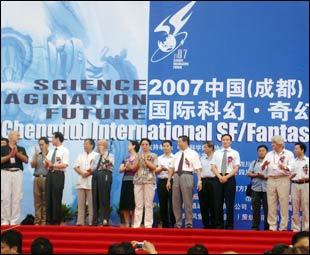
The 2007 China (Chengdu) SF/Fantasy Conference hosted the event. The theme: “Science, Imagination and Future” is an ambitious Chinese effort designed to inspire public creativity toward future scientific and technological development as well as promote national insight for scientific exploration. The conference has been scheduled immediately before the World Science Fiction Convention in Yokohama, Japan.
The conference has designated August 25 as “China Imagination Day”. SF and fantasy lovers signed their names on a banner to commemorate this day during the opening ceremony.
“Imagination is an important premise for creativity. Science fiction literature plays an important role in inspiring people’s imagination and creativity,” said Li Xiuting, vice director of the International Department of the China Association for Science and Technology, at the opening ceremony on Saturday.
“Our (science fiction) words become the world and our words become places that you can visit. They become books and stories that inspire people. It is both surprising and reassuring to know by accident that the places have helped to make a future we are now living. Places like Microsoft and Google, Apple and places like MIT are packed with science fiction readers and fantasy readers,” Neil Gaiman said on Saturday.
686 notes
·
View notes
Text
Midnight Pals: Sssspace Ssstory 2
JK Rowling: i don't need you lot! Rowling: i don't need any of you! Rowling: i'm gonna go over to sspace coven to tell my new sstory! Barker: yeah have fun with that Rowling: I will!! Barker: they're all a bunch of nerds over there! Poe: now clive that's not very fair Barker: she's gonna find it out soon enough
[meanwhile, at space coven] JK Rowling: hello children Jules Verne: welcome, JK Rowling! I've been informed that you're the first woman ever to write science fiction Verne: so we're proud to make you a member of our very select group Verne: welcome to super friends!!!
Verne: i am called Ham because I enjoy ham radio Verne: [pointing to HG Wells] this is email Verne: [pointing to Isaac Asimov] cosine Verne: [pointing to Robert Heinlein] report card Verne: [pointing to Frank Herbert] mescaline Verne: [pointing to Mary Shelley] and Mary
HG Wells: [arriving in a steam-powered dirigible] excelsior, fellow space-ka-teers! HG Wells: it is I, HG Wells, chrononaut extradinaire! Wells: i am simply a-quiver to hear some new story and- Wells: oh crap, the gears fell off my top hat Jules Verne: don't worry, my good man, you can borrow some of mine!
Rowling: ok sso here'ss my futurisstic sstory Verne: whoa you can't start a story like that! Rowling: oh? oh right, ssorry Rowling: i meant 'ssubmitted for the approval of sspace coven, i call-' Verne: no i mean you're not wearing any goggles Wells: every super friend must wear at least 3 pairs of goggles at all times Verne: it's the law!
Verne: won't you enjoy some of our "mind control cookies" ho ho ho Rowling: what Verne: oh i'm sorry are you not familiar with the music of dr steel??? Verne: he's ONLY our favorite musician Rowling: Verne: OMG you've GOT to listen to People of Earth Verne: it's SO funny Verne: we're all members of the army of toy soldiers Rowling:
Verne: [playing Dr Steel album] haha ok so this is my favorite part coming up HG Wells: are you playing dr steel? turn that hack off! Rowling: oh thank god Wells: you should be playing Aurelio Voltaire!
Verne: Dr steel! Wells: Voltaire! Verne: Dr steel! Wells: Voltaire! Rowling: I've been insspired Rowling: my next book is going to be a manifessto against the FuMP
Rowling: today i have an exciting new story for you! Rowling: those plebss over at midnight society couldn't appreciate this Rowling: FUTURISTIC story! Rowling: i think you sci fi people will really get this Wells: huzzah! Verne: huzzah!
Rowling: okay so Rowling: just imagine Rowling: a future world where a totalitarian government made up of blue-haired spoonies and their antifa goon squad Rowling: have made it illegal to be cis Rowling: one lone heroic terf is fighting for her right to be a gold star lesbian
Rowling: sssee, in the future, an evil coalition of trans autistic fat people Rowling: force innocent lesbians to put pronouns in their bios Rowling: or get sent to the woke gulag! Rowling: where they're forced to apologize for their privilege! HG Wells: i didn't understand any of that
Wells: i don't understand any of that Verne: me neither Robert Heinlein: me neither Heinlein: except that one bit about a lesbian being involved Heinlein: i did understand that word Heinlein: and frankly i think i would like to hear more about lesbians
#midnight pals#the midnight society#midnight society#edgar allan poe#clive barker#jk rowling#hg wells#jules verne#robert heinlein
82 notes
·
View notes
Text
Preferences: the Avengers visiting you, the owner of the local bookstore
Avengers x reader
warnings:
a/n: i hope it ok i turned into prefs!! i think it made more sense with the interaction part <3
prompt: @groovy-lady: “May I please request headcanons of being the owner of a bookshop the Avengers all go to and how they all interact with you?”

Bruce is there quite often, frequently in the scientific section. He buys stacks of books at a time and is quiet and polite when checking out. You always comment on how smart he must be and he awkwardly laughs it off. After a while, you start pulling certain books you’d think would interest him, which melted his heart when he realized you thought of him. “I added a science fiction novel in there, too. I don’t know if that’s your thing, but it’s one of my favorites.” You told him and he smiled. “Thank you for thinking of me.” He said.

Clint bought a lot of kids books. “How many?” You asked. “Three. Two boys and a girl.” He told you. You admired his choice of books for his kids. Teen fiction, sci-fi, graphic novels, fantasy, and a few children’s books. “Lots of variety.” You commented. “Yeah, trying to get them into reading.” He explained. “Any recommendations? The older ones are preteens, a boy and a girl. The little one is just learning how to read.” You smirked and started heading towards some classics like Percy Jackson, Harry Potter, and The Hunger Games. “These are the most popular for their age group, and I love them, too. As far as your little guy, you’ve already got the right idea.” Clint was grateful and took the first book of each popular series, promising to come back if they loved them as much you you did.

Nat was a fantasy reader. She had no shame in it. “What do you have for me today, y/n?” She’d approach the counter and have a small stack waiting for her. You’d go down the list with a little synopsis of each. “I hope you like them.” You told her. “You haven’t let me down yet.” She said back. She also donates her books when she’s done with them, saying she wants someone else to enjoy them as much as she did.

Steve nearly picked your history section clean. “Catching up, Captain?” You joked, recognizing the Super Soldier as soon as he walked in. “I don’t even know where to start.” He admitted. You gladly slimmed down his pile of history books and replaced quite a few with some fantastic works that came out while he was on ice. “As much as I enjoy reading, you won’t learn everything from these. Make sure you aren’t missing out by trying to catch up.” You warmly told him. “That’s good advice.” You told him you try and rung him up, warning him not to go reading those all at once.

Tony was more interested in comics and graphic novels, you’d laugh when you saw him pick up the more risque comics and he’d give you a playful wink. “They’re not for me, they’re for Clint’s son, the three-year-old.” He always knew how to make you laugh. “Yes, Elvira is the perfect choice for Clint’s small child.” He said he knew you’d understand. He also admitted he likes comics because they give him a little break from thinking all day and some of the characters remind him of his own life. You told him he was like Batman, he disagrees.

Thor checks out Norse Mythology more often than not. He likes to see what is written about him and his family in the eyes of Midgardians. “Are you sure you don’t want to try something different this time, Thor?” You motioned to a different section. “There’s so much more to choose from, I’d love to give you some recommendations.” Thor declined, placing another Norse book on the counter. “Have you ever read about me? Or my brother, Loki?” You nodded, telling him you’ve read a book or two that had them featured. “Wel”l, maybe next time I’ll buy something with a little less…me in it. We’ll see. Thank you, y/n!”

Before the Darkhold, Wanda was actually quite the enjoyer of teen fiction. She begged you not to tell the others what she read, and you promised you’d never share her secret. Most of the time, she’d cozy up in your reading corner with a coffee and read her “secret” books away from the Avengers. “Wanda, this one just came in. I think you’d love it.”
taglist: @locke-writes // @captainshazamerica // @summersimmerus // @prettysbliss // @simp-legend // @wild-rose-35 // @nekoannie-chan // @beth-gallagher22 // @mymelodymia // @deanzboyfriend // @mr-mxyzptlk-1940 //
#wanda maximoff imagine#steve rogers imagine#tony stark imagine#bruce banner imagine#thor odinson imagine#clint barton imagine#natasha romanoff imagine#avengers#avengers x reader#avengers imagine#marvel#marvel x reader#marvel imagine
92 notes
·
View notes
Text
The Last-Minute Sci-Fi Gift Guide
There's only one thing worse than procrastinating on getting gifts for your loved ones, and that's procrastinating on putting together a guide to help out everyone else with all those gifts. It's Dec 12, so you can decide for yourself which I'm doing.
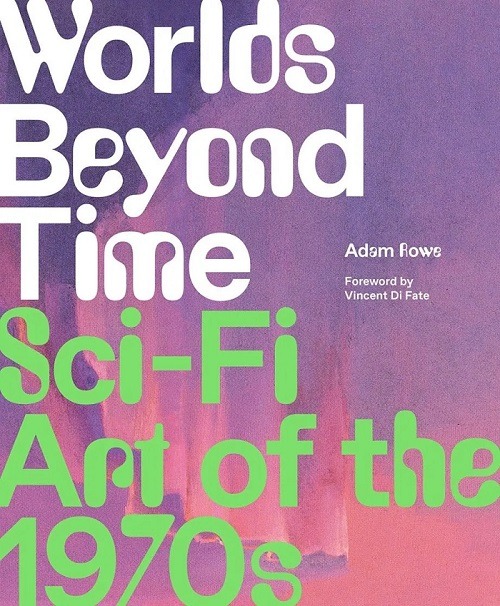
Art book: Worlds Beyond Time, $32
If you follow this blog, you might have heard of this one. I published Worlds Beyond Time: Sci-Fi Art of the 1970s this year after five years of work on it, and I think it's really good! 400+ images, 100+ artists, with lots of fun art history and jokes.
Also, it's just $20 right now if you order through my publisher and use the code SKIPTHELINE! Cheapest it's ever been!
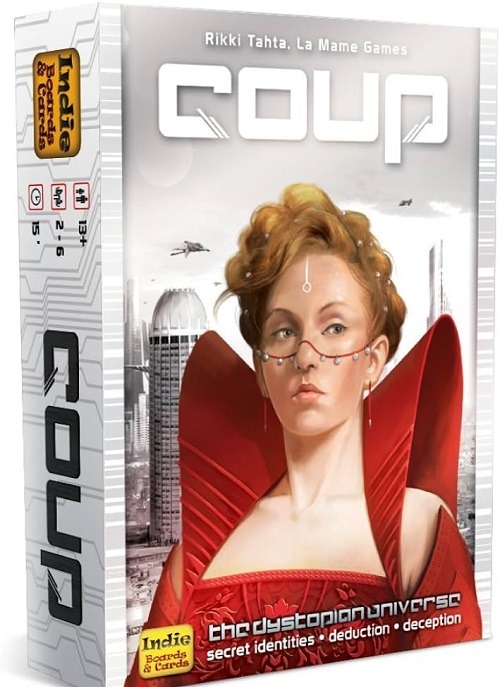
Card game: Coup, $14
In this "social deduction" card game, you play as a government official in a future dystopia who needs to backstab their way into power. Everyone starts out with just two cards in this bluffing game, so the tide can turn pretty quick when players start assassinating each other's cards. The fast pace makes it a good gift for someone who loves spies but thinks they don't like card games.
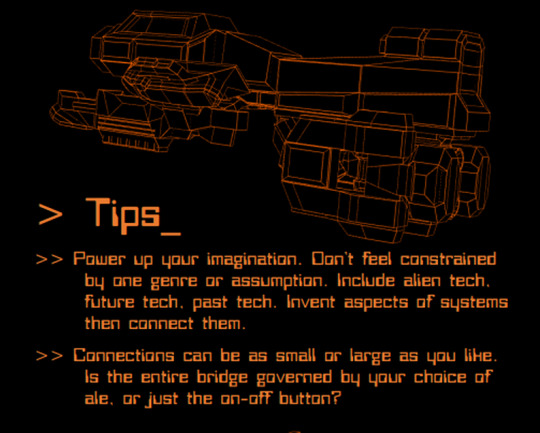
Game to play over Zoom: Bad Spaceships, $3
If a bluffing game stresses you out, try Bad Spaceships: It's a collaborative world-building game in which you roll dice to see what area of your spaceship connects to another, forcing you to spitball exactly why this is the case. As the game puts it, you might fix the hull by playing Tetris, or charge your weapons in the swimming pool. You're basically getting weird prompts to tell a story that can evolve over the course of the game.
It's such an indie game that it comes as PDFs you download from itch.io, but you can play it just as well over Zoom, if you're looking for an excuse to catch up with your old digital nomad college friend.
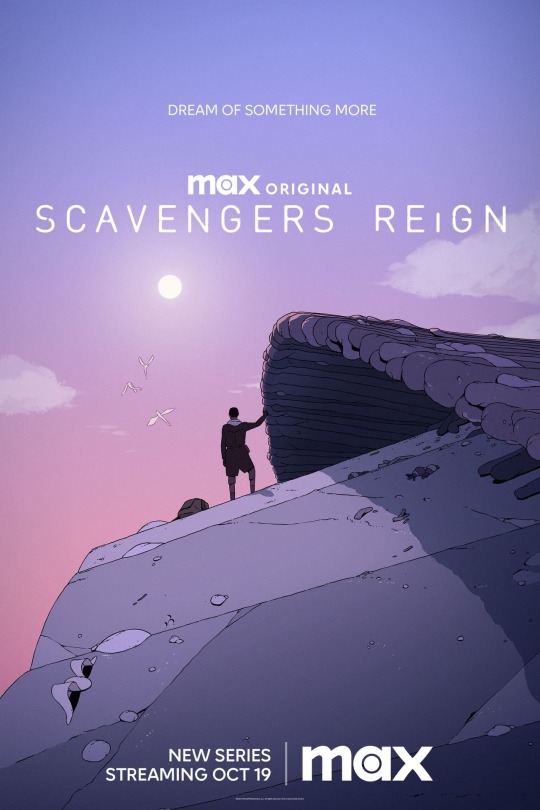
Movies/TV: Streaming service gift card
Gift cards are all well and good, but you can personalize them by recommending a few of your favorite shows as well. I suggest:
Hulu: Cowboy Bebop
Apple TV+: Severance
Criterion Channel: Ravenous, Paprika, Strange Days
Paramount+: Yellowjackets
Amazon Prime: The Devil's Hour
But to be honest, this entry is just an excuse to talk about the new Max show Scavenger’s Reign. Inspired by the work of French artist Moebius and with a clear debt to famed 70s animated film Fantastic Planet, this stylish sci-fi show features a bunch of humans trying to survive on a beautiful but hostile alien world. Perfect for lovers of fictional nature.
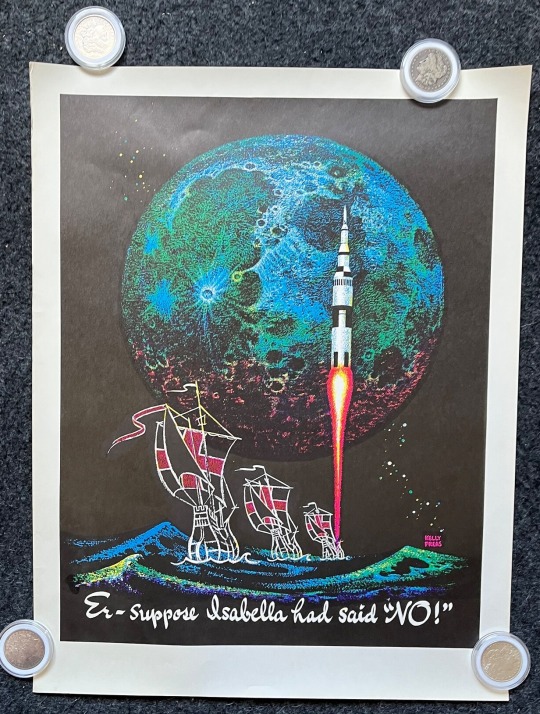
Vintage sci-fi
This Etsy shop has some good stuff, like the 1971 Frank Kelly Freas NASA poster above, a bit of history that I even mentioned on page 167 of my art book.
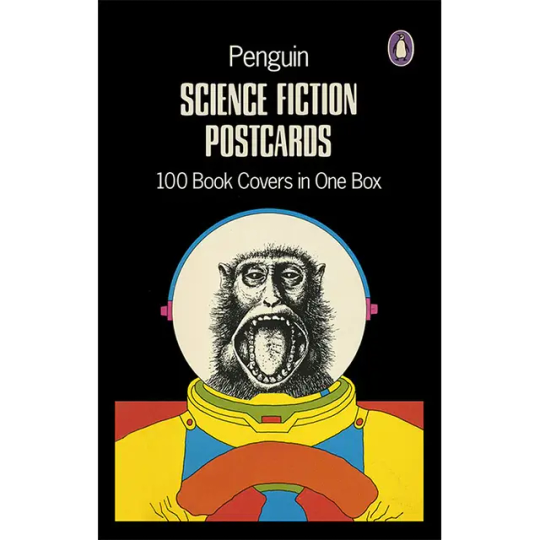
Penguin science fiction postcards, $28
These postcards have a ton of very cool sci-fi covers I've blogged in the past – great value if you want a lot of art for a low cost.
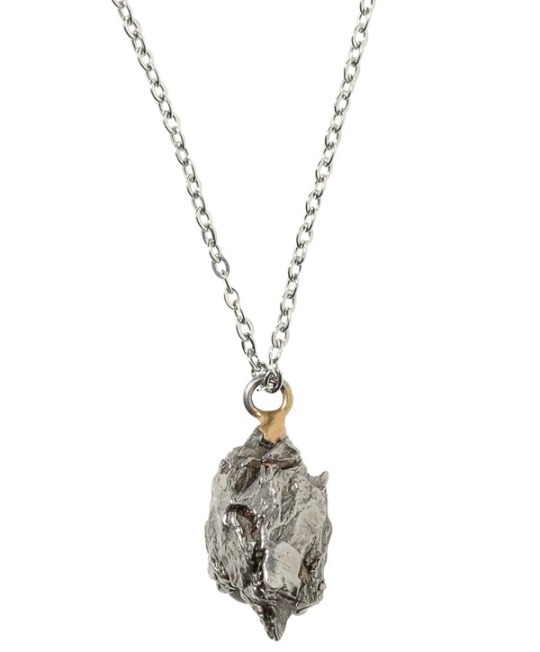
Meteorite pendant necklace, $34
I think we all know what kind of rock your loved ones need around their neck: A chunk of meteorite straight out of the 1576 Argentinan meteorite fall.
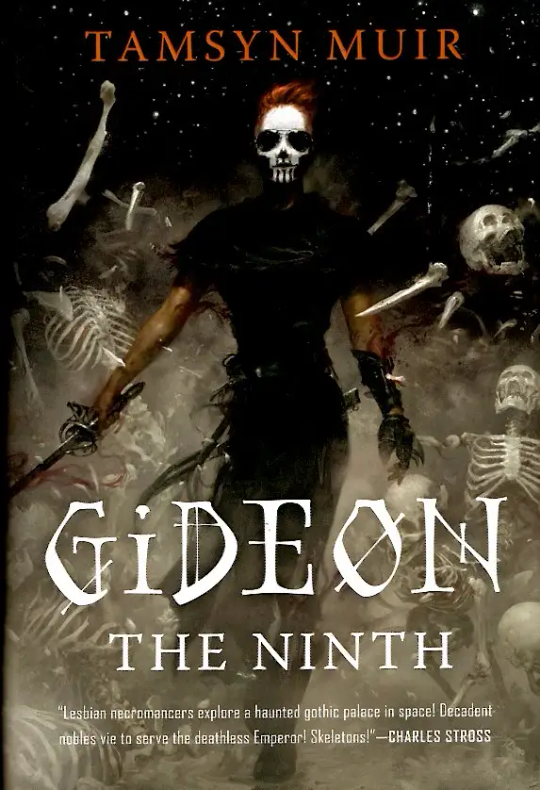
Book recs
For astronauts: Packing for Mars by Mary Roach, The New Guys: The Historic Class of Astronauts That Broke Barriers and Changed the Face of Space Travel by Meredith Bagby
For comedians: Gideon the Ninth by Tamsyn Muir, Even Greater Mistakes: Short Stories by Charlie Jane Anders
For sleuths: Six Wakes by Mur Lafferty, Drunk on All Your Strange New Words by Eddie Robson
For crafters: Knits of Tomorrow: Toys and Accessories for your Retro-Future Needs
For the resistance fighters: The Light Brigade by Kameron Hurley, An Unkindness of Ghosts by Rivers Solomon
For slasher movie fans: Clown in a Cornfield by Adam Cesare

Syd Mead "Biomorph Vehicle" button down shirt, $49
T-shirts aren't classy enough for the world's coolest visual futurist, Syd Mead. I haven't actually bought this incredibly odd shirt, but I really need to.
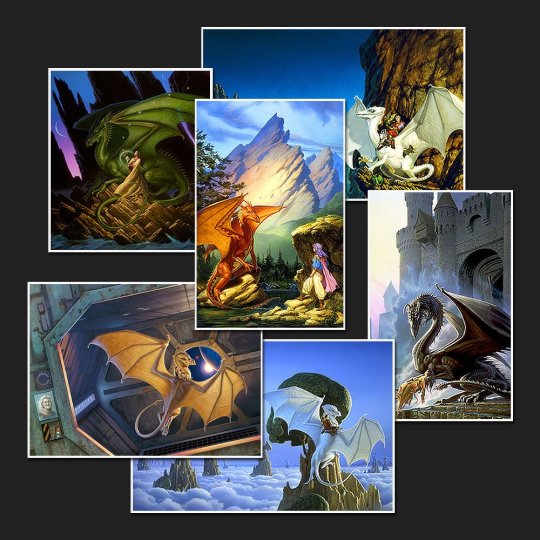
Art prints (and more) from 70s sci-fi artists
Artist shops can be surprisingly hard to track down on the internet, but here's a short list of ones I've come across. All of these artists are featured in my book (except one), so you can read up on them before you commit to a print.
Michael Whelan
John Harris
Syd Mead
Don Maitz
David B Mattingly
Peter Andrew Jones - Jones was one of just a few artists who declined to be included in my art book, but he has a distinct, colorful style that I would have loved to have featured!
Finally, here's one extra bonus, just for everyone who made it to the end of this article: The UK-based educational charity Centre for Computing History sells three big officially licensed John Harris posters featuring these three artworks, famous for their use as covers for Sinclair programming manuals.
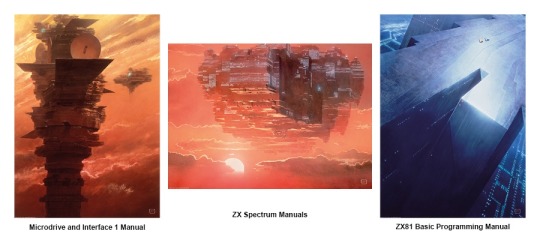
It's a great deal that I've never seen mentioned anywhere, and Harris' work has a timeless quality that makes it great for an unassuming wall decoration. If you're outside the UK, the shipping costs will be a pain, but there's no better deal for a classic sci-fi poster.
257 notes
·
View notes
Note
do you have any tips for writing speculative biology?

Speculative biology—(also referred to as "speculative zoology", though it is by no means limited to animals) is a sub-genre of science fiction which combines speculative fiction (i.e., Science Fiction, Fantasy, Alternate History and everything in between) with creature design, and deals with evolution in the future, on other worlds, or in alternate timelines, the same way that many other sci-fi works discuss technology.
This is one of the most fun sub-genres to explore. Here are just a few writing tips.
Read/watch a lot of media that plays with this sub-genre, and learn from them. Examples:
A Memoir by Lady Trent - Marie Brennan describes a low fantasy world with largely the same culture and animals as real life, but also home to very diverse dragons. The dragons are given extensive analysis through the character of Lady Trent, a naturalist dedicated to studying their taxonomy, anatomy, behaviors and ecology.
Dreamwork's How to Train Your Dragon - sometimes dabbles in this, displaying different types of Dragons as different species with a couple overlapping traits, implying that they evolved from a common ancestor. This is most prominently shown in Book of Dragons which describes at least 6 major taxonomic families of Dragons that most dragons in the franchise belong to.
Doctor Who: "The Lazarus Experiment" - has Richard Lazarus being mutated into a fearsome giant centipede/scorpion-like monster after an experiment with an anti-ageing machine goes wrong. The Doctor describes the monster as a creature of evolutionary potential — something that evolution could have turned humanity into if it hadn't gone the "two arms and legs, ten fingers and toes" route — lying dormant within Lazarus' genes.
Research a lot. Here are just a few resources that may help you in writing this sub-genre, particularly with creature design:
Here's a really good article that discusses some evolutionary rules
A brief resource on Evolution Rules
This article called, "Rules of evolution"
A Wildlife Fact Sheet
After doing all the research, and the devouring, and the hoarding of all the resources you can get your hands on, hoping they'll bleed into your story once you start writing, because admit it, you are procrastinating by asking this question—here is the writing tip that pervades all genre: let go. "Good writing is often about letting go of fear and affectation. Affectation itself, beginning with the need to define some sorts of writing as ‘good’ and other sorts as ‘bad,’ is fearful behavior." —Stephen King
So let your soul colour the pages. Particularly with this genre, allow your imagination to run free. Be as creative as you can. Because "when you write, you want to get rid of the world, don’t you? Of course you do. When you’re writing, you’re creating your own worlds." —Stephen King
Sources: 1 2
Hope this helps. Please tag me, or send me a link if it does. I would love to read your work!
More: Fantasy ⚜ Writing Notes & References
#anonymous#speculative biology#sci fi#fiction#writing tips#writing advice#writeblr#writers on tumblr#poets on tumblr#writing prompt#dark academia#spilled ink#writing reference#poetry#literature#stephen king#writing inspo#writing ideas#writing inspiration#writing motivation#creative writing#light academia#fantasy#character building#character development#character design#writing resources
90 notes
·
View notes
Text
when robots got muscles
You can blame @centrally-unplanned for this post. She(?) wrote...
The ‘chrome’ designs pioneered by illustrators like Hajime Sorayama (Sexy Robot from 1984, for example) tended to be more in vogue at this time (or just…a hot girl, who is apparently a robot, trust me bro), you don’t see designs like this too commonly until later (ask resident robo-fetishist/animator expert @canmom for details on that timeline).
After a challenge like that how can I refuse? Although the question is ‘when did robots get muscles’, this turned into something of a historical survey of robot designs from the 80s on with a throughline of biomimesis.
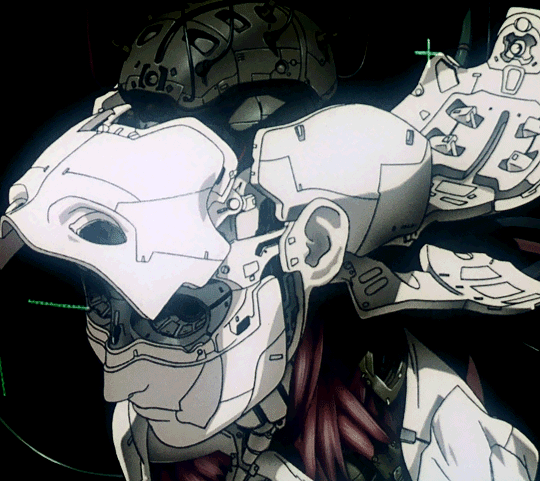
(Originally this was just going to be an excuse to talk about Ghost in the Shell... but I gotta be thorough.)
This was all brought on from this picture from a 1989 fanart magazine...
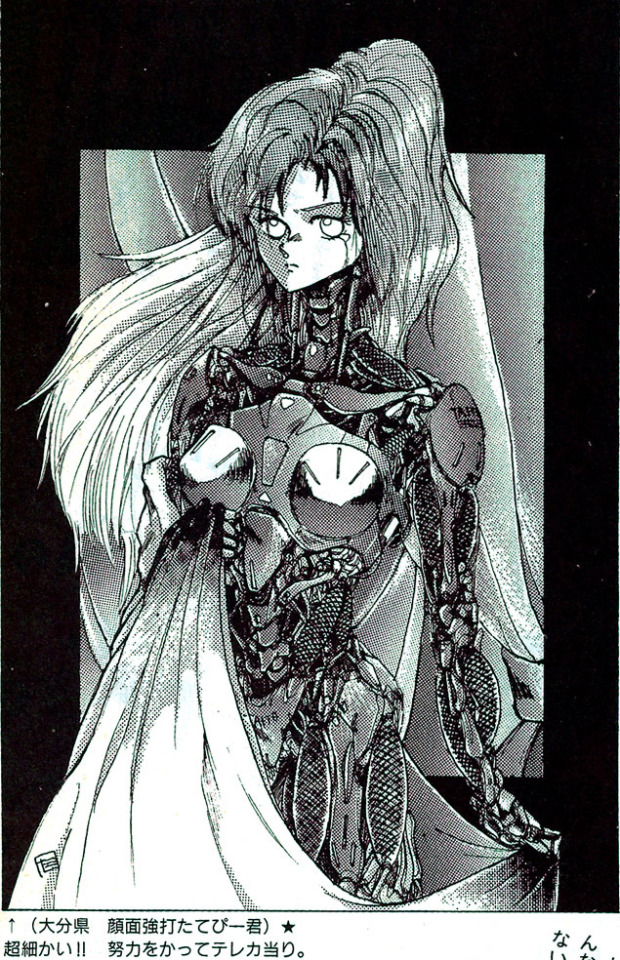
by an artist going by ‘Facepunch Tatebi-kun’ (顔面強打たてびー君, Ganmenkyouda Tatebii-kun). I remarked that it was interesting to see these kinds of ‘robot muscles’ in a picture from 1989, since I thought that kind of design became popular in the 2000s.
On some reflection, I think I gotta revise that opinion! I think ‘robot muscles’ became a thing around the mid 90s in anime; in the West I think it took a bit longer. But you can also see precursors already before that.
So. One thing artists are super into is biomimetic robots. That is, robots whose form (and perhaps function) is similar to animals, especially humans. The word ‘android’ referring to a human-like automaton dates all the way back to the late 19th century, but the modern ‘android, robot, cyborg’ taxonomy apparently became established around the 40s.
There’s two types of humanoid robot that get a lot of play, especially in anime. One is the convincingly humanlike cyborg, which is the same size and shape as a normal human; the other is a what we call in English a ‘mech’, i.e. a big robot you can sit inside.
Of course, if your androids just act like humans all the time, then there’s not much point having them be robots. To really create the frisson of contrast between human and mechanical forms you have to show the mechanism somehow. This could be because the machine isn’t perfectly human-like, and has visibly mechanical joints - take a look at the works of @sukabu89 for very inventive depiction of this theme - or, the android could be damaged or undergo maintenance.
When you attempt to translate biological forms into a more mechanical design language, the traditional way has been to use hard, rigid shapes, since these make the contrast especially clear. In more recent designs, particularly as we started to see real robots with ‘artificial muscles’ such as the ones created by Boston Dynamics, we get another sort of design language to express ‘mechanical parts’, and robots start having more biological forms with exposed plasticy muscles.
So let’s tell the story. We begin at the end of the 70s.
the dawn of mechaguro
For an early example of ‘mechaguro’ (a term I’m applying very anachronistically!), when a robot gets smashed up, we have Alien (1979). This film did a ridiculous amount to define sci-fi design language, and of course the alien itself blends mechanical and biological forms, with its glossy black surface allowing it to seem to melt into the exposed pipes of the spaceship. But let’s focus on the character Ash, a secret android who is broken apart in the second half of the film.
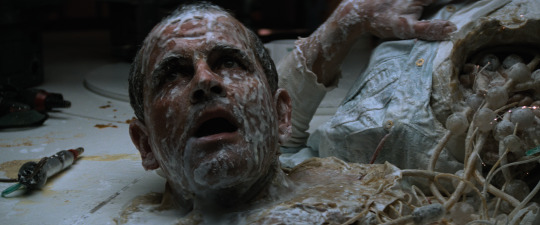
When Ash is torn apart by the alien, his insides consist of weird white plastic beads and a milky fluid that seems analogous to blood. It’s not clear what the function of any of this tech is - it’s intended to be vague and mysterious. The outside is biomimetic but the inside is anything but. He has a kind of artificial skin which resembles a latex mask.
The Terminator films are another major touchpoint for 80s science fiction. Late in the film, Arnie starts taking damage which reveals the Terminator skeleton underneath his fake skin.
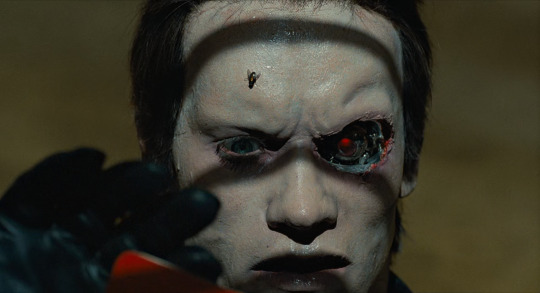
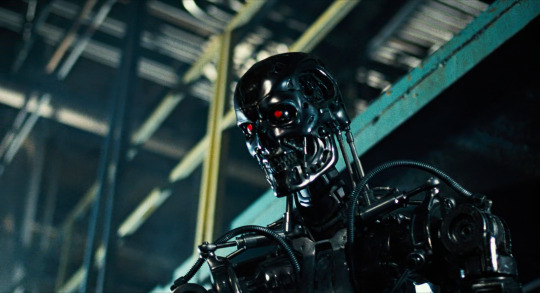
The stop-motion Terminator model is basically designed according to the principle of ‘replace human bones and muscles with hard metal bits’. So you have a metal skull, metal clavicles (which are pistons for some reason), metal shoulder blades, hydraulic pistons generally in the places where muscles are. e.g. in the above picture you can see pistons that stand in place of the sternocleidomastoid muscle, and in this picture...
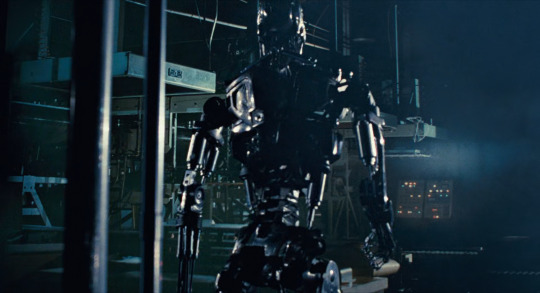
...you can see metal scapulae and piston biceps and triceps and a piston. The shoulder joint by contrast built in a very non-human-like way. Also there’s random tubes everywhere lol.
That’s generally how androids are portrayed in the 80s. The ‘droids’ in Star Wars are similar; C-3PO is an arrangement of metal plates with gaps suggestive of underlying mechanical details and rudimentary joints and pistons.
In Blade Runner, we have the Replicants, humanoid robots - but by the premise of the film, they are essentially indistinguishable from humans. So when the Replicants die, we never really get to see their robo-innards.
and now, anime
OK, that’s the big four Western 80s sci-fi movie series; what of anime? Of course, androids in anime go all the way back to Astro Boy. But most of these early designs don’t really focus on mechanical details all that much. Super robot designs are more like tokusatsu suits than anything. There were certainly instances of impressive mechanical animation in the 70s, with early experts including Kazuhide Tomonaga on Space Battleship Yamato. Then there’s Hayao Miyazaki’s episodes of Lupin III Part 2 which featured proto-Nausicaa flying a prototype of the robots from Castle in the Sky. It would be some years before anyone could come close to matching these!
The original Gundam in ‘79 famously started the ‘real robot’ movement [Animation Night, so let’s take a brief look at how a Gundam fits together.
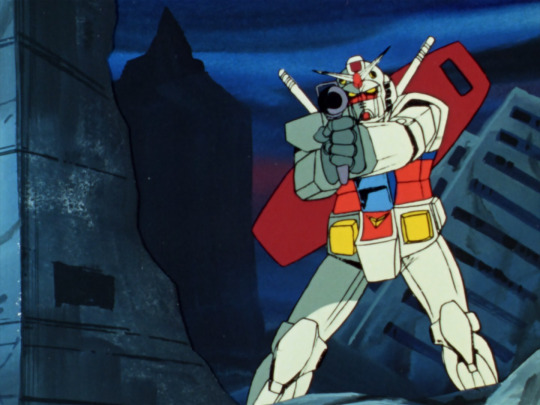
Generally speaking, the way Gundams are drawn in Gundam ‘79 is kind of rough. The methods to animate these rigid mechanical systems in super accurate perspective were just not yet established at the end of the 70s, certainly not on a TV budget. The actual joints on the Gundam are left very vague, but it broadly speaking seems to move like a human in armour.
But the OVA boom was about to begin, and while it would be a while before we saw the heights of Headgear/Production I.G./Gainax, things were going to change a lot. Mechanical design and animation was about to get much more sophisticated very very quickly.
In 1982, we have Super Dimension Fortress Macross, with robots that transformed into fighter jets. Its robots are designed by Kazutaka Miyatake, who cut his teeth doing mechanical design for Space Battleship Yamato and Daicon. The Macross TV series introduced the world to the animation of Ichirō ‘Missile Circus’ Itano. [AN64] A plane with legs... honestly looks kind of goofy, but Itano’s ambition to have a highly mobile 3D camera that could move in ways that would simply be impossible in live action marked a huge step up in how robots are animated. And this would get refined even further in the film Do You Remember Love.
In terms of design, we’re really moving our inspiration from ‘tokusatsu suit’ to ‘military hardware’ here. A Macross suit has to look like something that could transform into a plane, so its silly little arms and legs have to look kind of plane-like. In any case, we are definitely still in a world of hard and rigid robotics.
Dallos (1983-4) dir. Mamoru Oshii is known as the first OVA, if not the first successful OVA [AN115]. It features a variety of mining robots on the surface of the Moon, which are generally less humanoid, taking their design cues from JCBs...

...as well as humanoid robots with fairly clear joint patterns...

...and more humanoid robots too.
The eponymous Dallos, however, is a huge humanoid robot that looks like this...
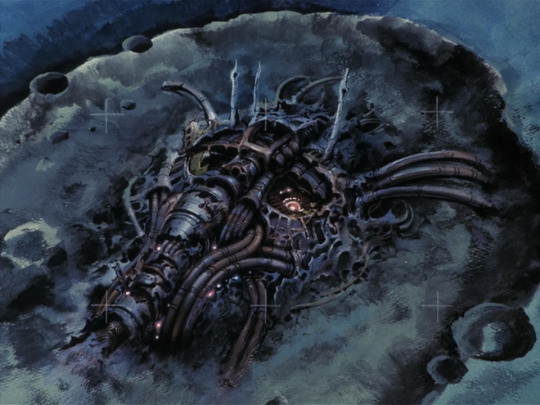
Here we have a pile of mechanical shapes that vaguely calls to mind a human face. It’s suggestive of motifs we’d see later in works like Akira.
A year later in 1985, Megazone 23 really kicks off the OVA boom in earnest [AN 103]. It also has a robot, in the form of a transforming bike that can become a humanoid piloted mech...
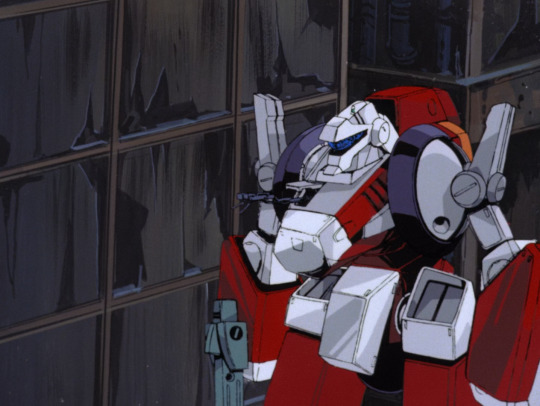
You can see mechanical designs and shading have become considerably more detailed; its motion is a lot more complex as well with a ton of indulgent background animation shots. The actual details of the bike -> robot transformation are rather brushed over. But to sort of sum up the design language: we have organic but hard-edged shapes contrasted by inorganic but round shapes. (These terms ‘organic’ and ‘inorganic’ refer mostly to symmetry and a sense of ‘flow’ in the shape.) There are few right angles as such, but a lot of broadly boxy topology. The shapes are broken up by elaborate specular highlights in complex shapes, a motif of the later Kanada school.
OK, but that’s all variants on ‘rigid robot’ so far - what about the androids? What about the more directly biological designs?
Following the enormous success of Megazone 23 Part I, Toshiki Hirano got the chance to adapt his favourite lesbian cosmic horror hentai manga Fight! Iczer One into a rather more tame OVA which released from 1985-87. In terms of mechanical design, this starts to do some interesting moves towards blending biological and mechanical forms...
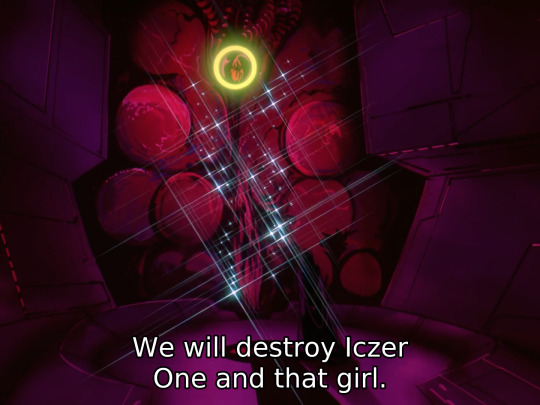
Of course it has a robot in addition to the requisite bishōjo and lightsabers. In contrast to the boxy shapes we’ve seen so far, the robots in Iczer-One have a much more curvy organic sort of design language. Still, there is not a lot of emphasis on the precise details of mechanical articulation outside of select shots. (It is however notable for the first ever Obari punch!)
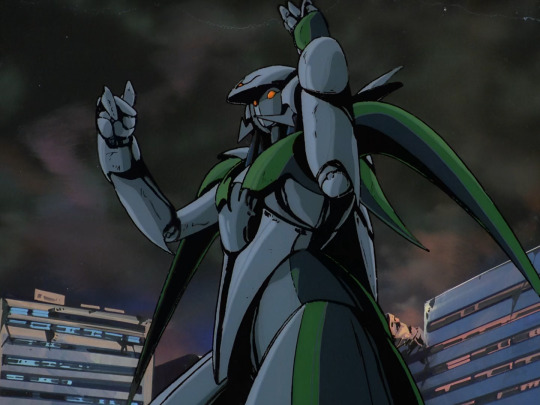
Despite the change in shape language, these are still very clearly animated as metal plates and not yet muscles.
In 1984 we have a very important film (for this narrative, and in general), Nausicaa of the Valley of the Wind, the film that created Studio Ghibli. Here we have the ‘God Warriors’, giant humanoid weapons with the ability to shoot a massive laser out of their mouth. Rather than robots, these are very much biological in nature, having to be grown in a kind of cocoon. In the film version of Nausicaa, an incomplete God Warrior is released, leading to an iconic scene animated by Hideaki Anno in which the God Warrior attempts to blow up the oncoming wave of Ohmu.

The God Warrior’s melting flesh is gorgeously animated, bubbling and sloughing off in great big lumps as the skeleton pokes out from underneath. Throughout, Nausicaa is full of beautiful and impressive animation of both machines (mainly planes) and biological (the giant insects), but the God Warriors, as human-made lifeforms, bring the two together. However, this strand wouldn’t be especially followed up on for a long long time.
Right, but what about Bubblebum Crisis (1987-91)? That is, after all, the iconic 80s robot girl OVA. It’s inspired heavily by Western robot-related films like Terminator and Blade Runner; here we have ‘Boomers’ (never stops being funny) as androids that can appear convincingly human. Like the Terminator, the underlying metal parts can burst out. Here we have a metal frame designed to resemble muscles, and also metal tentacles.
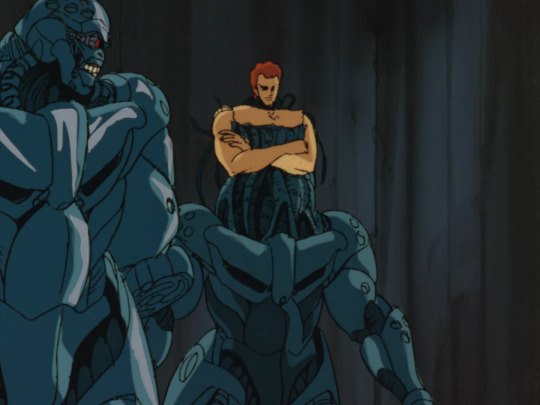
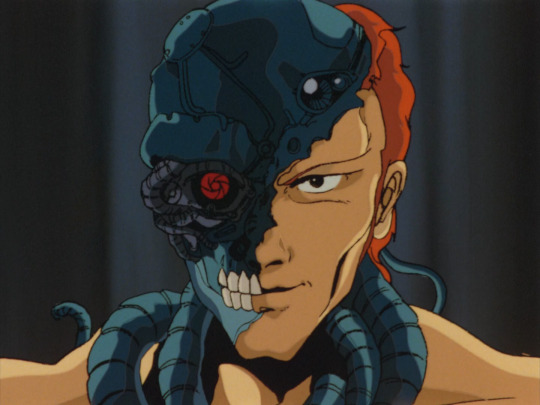
The shapes of these robots are a lot more organic. The robot neck has tubes that sort of resemble the neck muscles, metal plates that resemble pectorals and abs and deltoids and biceps and so on. You’ve even got a direct riff on the Terminator ‘fleshy face falling away to reveal metal skull with glowing red eye’! Under the plates there are clusters of tubes which also heavily resemble muscles. Also you’ve got the classic ‘three small circles’ motif there.
Contrasted against them are the Knight Sabers, who aren’t cyborgs as such but fight in powered exoskeletons which fit the design motifs of robot girls.
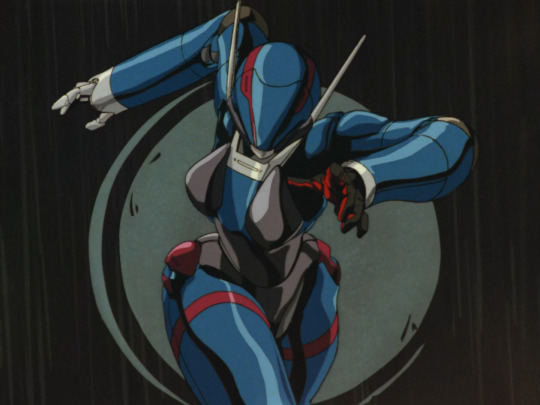
These suits are quite form-fitting, with a rubber under-layer and metal shells on top. There is definitely some attention paid to how they’ll articulate around the joints. One very recognisable 80s motif is the sort of extending spike thingies you can see on her hat there; there’s also the jets that extend out behind the suit. And, you have that multi-layer shiny highlighting of course!
Still, the way the characters move in Bubblegum Crisis is still very squarely Kanada School poses; big movements, lots of held poses accentuated by flashing and line boil, not a lot of concern for conservation of momentum or anything like that.
For a contrasting strand we can look at the rise of the ‘Otomo school’ (if you will) of realism. Around the end of the 80s, a pool of talented animators were gathering around Katsuhiro Otomo. Their most famous work is Akira, but I’m actually going to begin with Robot Carnival (1987), a wonderful anthology of short films from 1987. This features a huge variety of interpretations of the concept of robots.
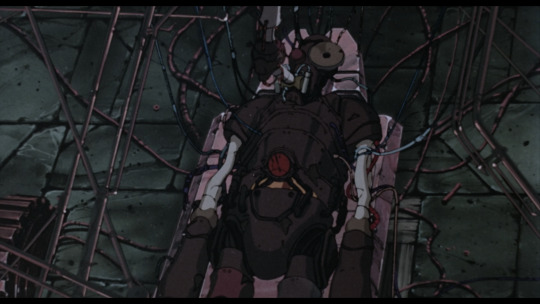
For example, for Kōji Morimoto, later co-founder of Studio 4°C, the robot is a kind of cobbled-together steampunk Frankenstein’s monster. It’s a very cool design with all sorts of asymmetries and exposed parts suggesting its cobbled-together nature. And although all the robot does in this short is stand up and then fall over, a great deal of attention is paid to the little details of its articulation and its movement through space.
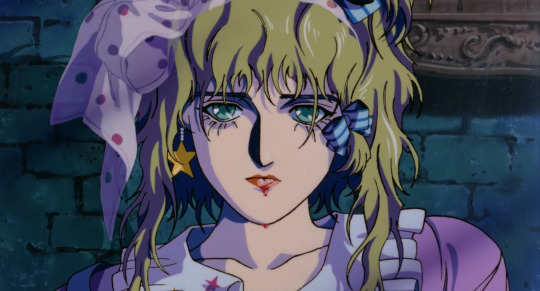
Presence, directed by Yasuomi Umetsu, is notable for its steps in the direction of realism - Umetsu’s characters are hyperdetailed and in some ways over-drawn. The opening shots establish this is a world where lifelike androids are common, when an android gets his head kicked off and stolen by children. Here the robot-as-doll metaphor comes in, something that will be increasingly central in the next decade. The robot girl is essentially a human-sized doll in a room full of other toys. Her creator smashes her to pieces with a wrench; later her ghost visits him as an old man. We see the girl attached to a bunch of wires, but she bleeds like a human.

Cloud by Manabu Ōhashi features another humanoid robot, an Astro Boy-like child recognisable as a robot based on his segmented torso and legs and robotic ear... cones. Here the robot is a standin for human emotions, the boy’s struggles projected onto the constantly changing sky as he walks against the wind.
Strange Tales of Meiji Machine Culture: Westerner’s Invasion by Hiroyuki Kitakubo (later to direct Golden Boy, Roujin Z and Blood: The Last Vampire) is a sendup of mecha shows in which two very goofy looking steampunk robots operated respectively by Japanese and Western crews duke it out, laying waste to the city around them. The Japanese robot is basically a big wooden samurai...
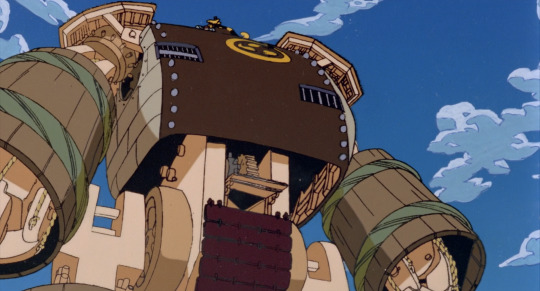
and the Western (more specifically American) robot is, uh
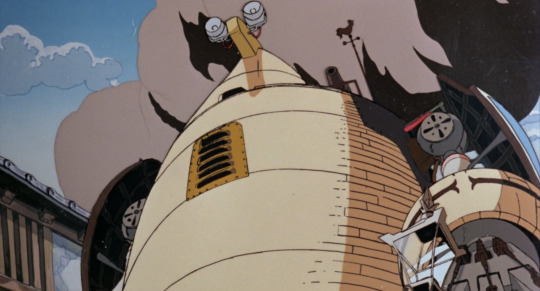
sorta big barrel with little eyes on top? I’m not entirely sure what the deal is with this design!
That’s really not relevant to our story tbh I just think it’s a neat short.
Chicken Man and Red Neck, by Takashi Nakamura, features especially distinctive robot designs. The film is kind of a dream sequence in which a terrified drunk man witnesses the revels of the machines of Tokyo, transformed into robots; the robots are extremely shaped, moving through a world that is pretty much just pistons...
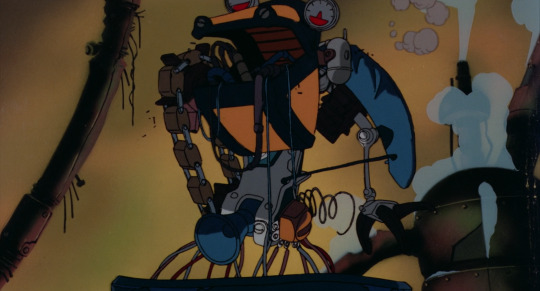
These robots call to mind the dancing demons in Fantasia’s Night On Bald Mountain sequence, or even Bosch.
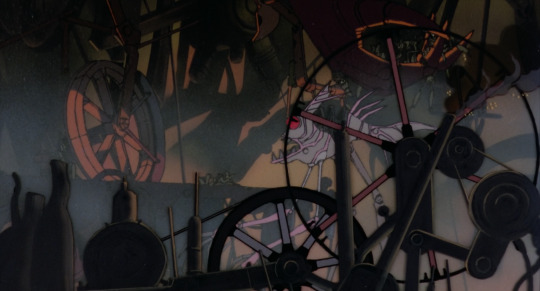
Otomo’s own segments feature the Robot Carnival itself, a vast mechanical structure built as... well some kind of entertaining spectacle, but which now drives around the post-apocalyptic wasteland dropping robots which explode as bombs. It’s cute.
OK, to wrap up the 80s, we gotta cover Akira (1988) [AN34]! Akira has plenty of impressive mechanical animation of helicopters, hovercraft thingies, satellite lasers and of course the famous bike, but it doesn’t really feature robots as such - but what it does have is a blending of mechanical and biological forms in its climactic sequence where Tetsuo���s psychic powers go out of control. First, wires start to spread like the roots of a plant from his robot arm - less an actual machine and more something he assembled with his psychic powers...
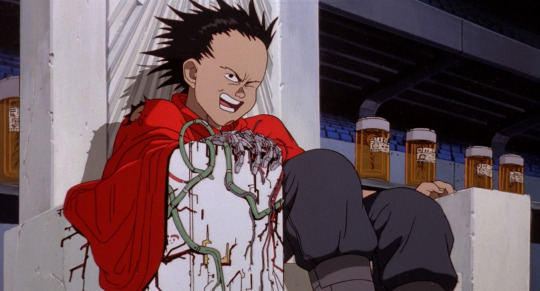
He takes a bullet, and the mechanical wires and muscles start to blend together and spread out like a slime mold...
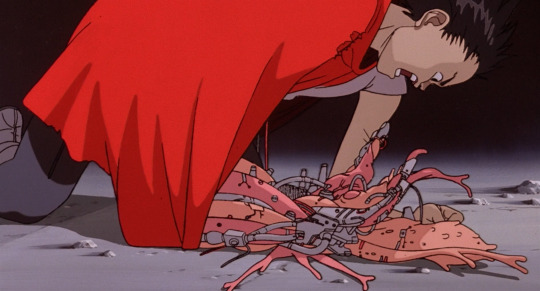
...which he can extend as essentially a giant tentacle.
When his powers fully go off the rails, he bulges out into big blobs of flesh which have both veins and wires running over them. These burst out of the metallic parts as well.
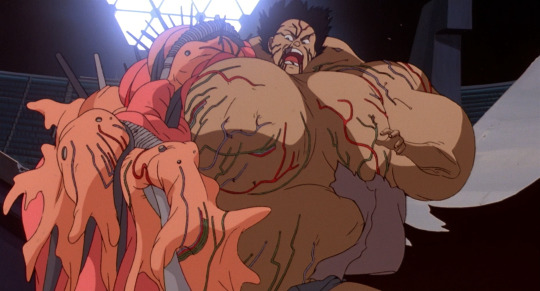
He turns into essentially a giant biomechanical baby.
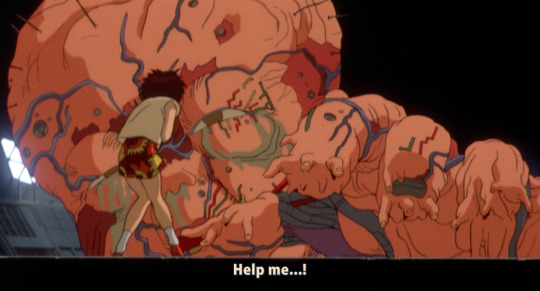
Did Akira invent these images of blending biology and machinery? Probably not, but I’m not really familiar enough with manga of the time to say. What can at least be said is that Otomo’s absurdly meticulous style could really sell it. Otomo was truly a god of perspective and detail; Akira the film was an enormous, prestigious production that threw ludicrous effort and resources towards realising his vision (which doesn’t mean it paid its inbetweeners much more...). A lot of the animators who worked on Akira would go on to be prominent in...
the 1990s
So, the 1990s. If the 80s was dominated by the later Kanada School, the new movement of the 90s, at least as far as film animation goes, was ‘realism’.
But before we get onto that, let’s take a brief look at Gunnm (1990). Known as Battle Angel Alita in the West, this manga by Yukito Kishiro depicts a world in which most people are cyborgs; it was adapted to an OVA by Madhouse in 1993 and became wildly popular overseas. Its protagonist Gally, aka Alita, starts out the story as a wrecked cyborg body like this...
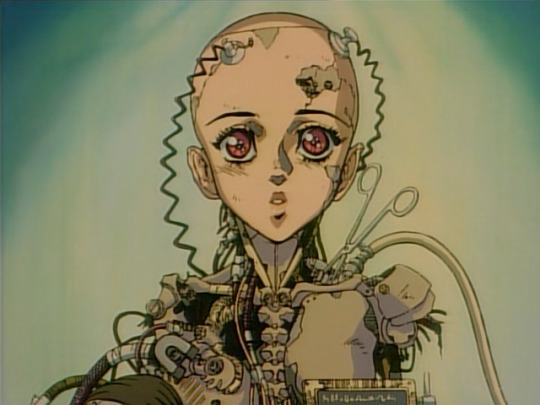
Looking at this design, you can see similar patterns as we have so far. We have metal clavicles, metal sternocleidomastoid muscle, metal pectorals, metal spine. There aren’t robot muscles, per se, but there’s a lot of attention to detail on mimicking biological shapes.
Before long she is rebuilt (twice in the manga, once in the anime). Her new body is like this...

...which is to say a skintight bodysuit in the middle, and metal arms. These arms, although designed in a way that indicates hard surface and with a hinge joint at the elbow, are designed in a way that mimics the flow of muscles in a human arm. By contrast, her sorta-love interest Yugo has a body like this:
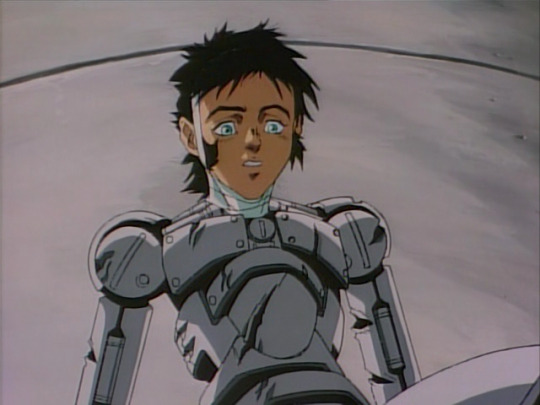
which gets mashed to pieces in the finale of the OVA. There’s a striking mechaguro scene in which Gally catches Yugo, but leaves him hanging by a fraying arm, which snaps, leaving him to fall to his death. Compared to later iterations of the ‘robot arm torn apart’ device, this one’s relatively light on detail...
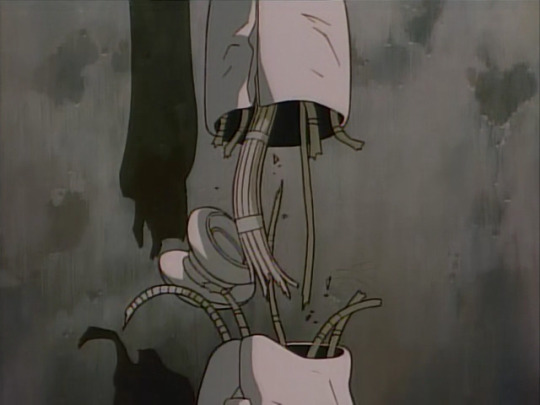
Cyborg bodies in Gunnm are used as a visual indication of character type. Gally has curves but also sleek robo muscles: she’s a Beautiful Fighting Girl, sweet but also extremely powerful. A huge ‘muscular’ cyborg with wide shoulders is likely to be a brute. Yugo here has much more plain, simple shapes with visible bolts, not precision pieces like Gally.
I don’t know how much of this originates with Gunnm. I’m sure the idea of cyborg girls was in the air long before, but this became an influential example on the tail end of the time of the 80s bishōjo. One device that is notable here is the idea of a ‘full body cyborg’, which is only human down to the brain (or perhaps not even that). Body swapping is a major theme in Gunnm, something that would be expanded on before long...
And if that was going out, what was coming in? Let’s look at Patlabor, which traces the evolution of the Headgear artistic collective and IG Tatsunoko into Production I.G.. This is about as down to earth as giant robot stories can get, with robots as just everyday machines used for work and by the cops. But where things really go nuts in animation terms is the opening to Patlabor 2 (1993).
youtube
Here you can see some of the most impressive sequences of mechanical animation ever drawn. We see pilot Noa testing out the robot, and especially notable are the scenes of the hand flexing and of walking. Enormous attention is paid to the articulation of joints. The robot’s hand can swivel 360 degrees, unlike a human; however, like a human, the articulation of the fingers seems to be controlled by hydraulics in the forearm (whereas in humans, the muscles and tendons in the forearm control our fingers). When the robot’s foot steps, it flexes like a real human foot, with believable joints, and a sensible arrangement of pistons to absorb force.
It’s not imitating a human’s muscles, but the attention to the details of the robot’s mechanical design serves precisely to draw our attention to the ways it’s like/unlike a human - the robot’s hand impossible motion immediately contrasted with its pilot shot from the same angle. And the perspective drawing is absolutely impeccable. The robot is made of purely rigid structures, and the way rigid structures articulate is not at all how a human’s joints articulate.
The sequence above was animated by Atsushi Takeuchi. But across the board, the bar was getting pushed for mechanical animation. For example, observe this cut from Mobile Suit Gundam: The 08th MS Team (1996-1999), in which the robot tears off its own arm and beats up another robot. The precision of the way the joints are animated and the way the robots move in space is just completely on another level compared to what Gundam had been doing a couple of decades prior.
Anyway, we’re here to talk about robot muscles, and we’re just a few years out from that now!
The year that robots got muscles, at least as far as anime is concerned, is 1995.
You can probably guess the next part. In 1995, we get Eva and GitS. Let’s start with GitS, to continue the Production I.G./Mamoru Oshii thread. The opening sequence of GitS, animated by - who else could it be? - Hiroyuki Okiura - has to be one of the most iconic segments of video ever drawn. Here’s a merely 720p youtube upload but go and find the place you have GitS stored on your hard drive and watch it in proper quality eh.
youtube
OK, yes, a lot of it is a naked lady floating around, sue me or whatever. But the sense of form. We see early on an appearance of ‘robot muscles’, here closely resembling real muscles...
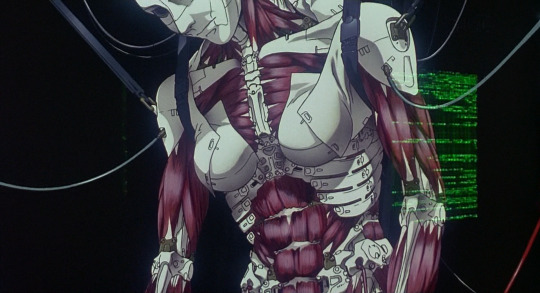
We can see from the way this is drawn that it’s made of a combination of artificial muscles, solid segments, and flexible, fabric-like panels. One of my favourite shots at the beginning shows the solid segments of the skull clicking into place. Here we have a very clear contrast between the angular, hard edges of the mechanical pieces against the organic forms of a human body.
Elsewhere in the film, we see various incredibly cool bits of ‘wouldn’t be fucked up if a body did this‘, like the fingers...
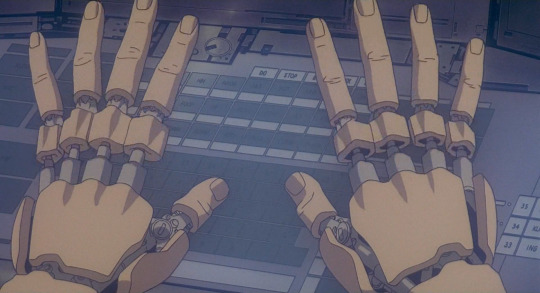
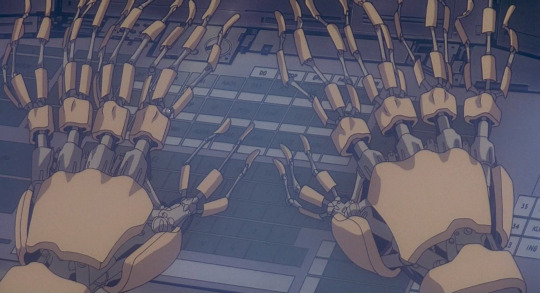
Here, what we expect to be soft biological fingers is contrasted with unexpected rigidity, mechanical joints under a shell.
Also in this scene we encounter a robot body that has been stripped of her arms, legs and hips but is nevertheless still alive...
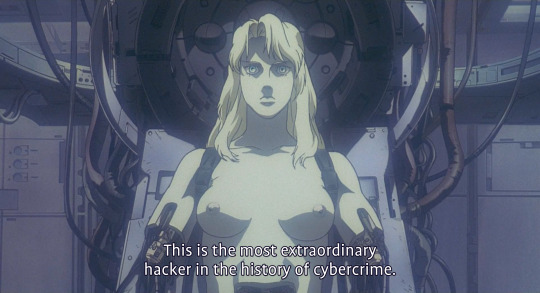

most extraordinary hacker in the history of cybercrime and you have your titties out and yet you still can’t get them to stop misgendering you, smh
For the Terminator, having its body smashed up and continuing to walk was a demonstration of its strength. Here, as would become perhaps an increasing motif, having a robot body is a source of vulnerability: people can do things to you that would kill an ordinary human but you keep going through it. Not surprisingly, ‘robot body maintenance’ is a recurring porn device. (One that GitS deploys in SAC s2).
But of course this all builds up to the all time classics of mechaguro scene at the ending where the Major attempts to tear off the hatch of a spider tank. Muscles ripple individually under the surface of her skin, her arms bulge in exaggerated contraction, and then her arms fully tear apart under the force.
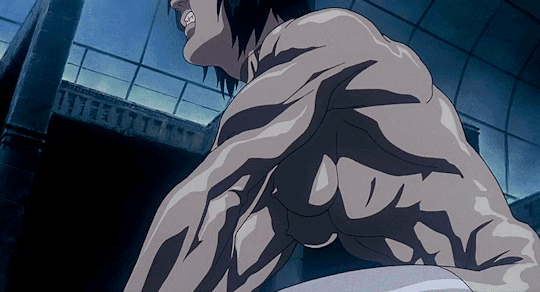
Here, we’re showing her as mechanical not by contrasting rigid forms with biological ones, but by exaggerating the biological ones to the point of doing something extremely unnatural. Human muscles do not generally flex in such an individual way, nor are they strong enough to tear the arm apart, but robot muscles? Yeah, they could do that. This sets up the next scene where the Major lies unnaturally still, but can still exert control through hacking through her union with the Puppet Master.
Robots holding onto something so hard their arms explode has become... if not a recurring image, then at least one that was called back decades later in Violet Evergarden.
The final scene of GitS brings back the image of robot-as-doll, with the Major’s consciousness now uploaded into a black-market robot body that resembles a child in a dress.
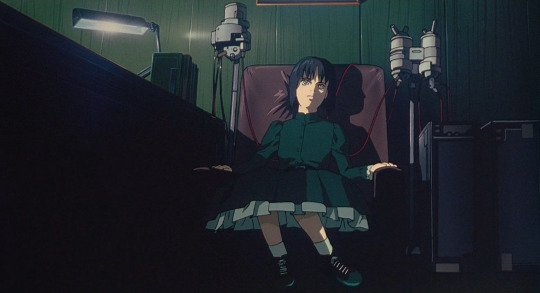
This is further expounded on in Oshii’s second GitS movie Innocence (2004), with its Ballade of the Puppets in the soundtrack as Batou and Togusa (and eventually, the Major) are attacked by essentially an army of ball-jointed doll gynoids. The puppets’ movements are extremely unnatural and erratic acrobatics, constantly flipping all over the place; when hit by bullets, panels pop open to reveal the underlying brass skeleton. It’s a very cool image. (The thing that lets the sequence down is the extremely dated CGI and aggressive digital compositing.)
It also has Donna Harraway as a literal cyborg!
Now, the GitS movies didn’t drop fully formed out of nowhere, but draw on the work of Masamune Shirow. The manga has a somewhat different design sensibility than the movie, distinctive and shiny as all Shirow’s art. It is more rounded and organic, less cold.
So, the basic design of a cyberbody originates with Shirow. You can see it on this page (unfortunately from a flipped version, translation Dark Horse):

You might be able to determine from how the nurses are dressed that, yeah, the GitS manga is in significant part fetish porn. But really nerdy fetish porn, which is the best kind. This chapter is almost entirely dedicated to explaining how cyborg bodies are constructed in great detail, from the ‘sensory film’ (that’s what’s being applied in the opening to the 1995 film) to the hair implantation.
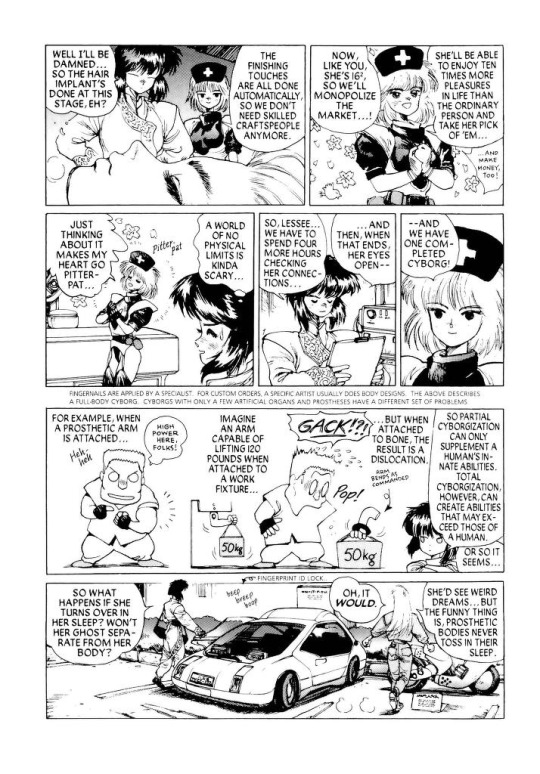
It’s interesting seeing how some of the more out-there designs of the manga, like Chief Aramaki, are transformed into the realist style of Hiroyuki Okiura. It’s Okiura, so it works great of course.
I don’t know if there are manga examples of such detail about cyborg bodies that predate Shirow.
Anyway, that’s just one of the two punches dropped in 1995. The other is Neon Genesis Evangelion. To the pedants: sure, the Evas are not actually robots, but they’re giant cyborgs that play the role of ‘robot’ in the story and they look like robots so I’m counting them.
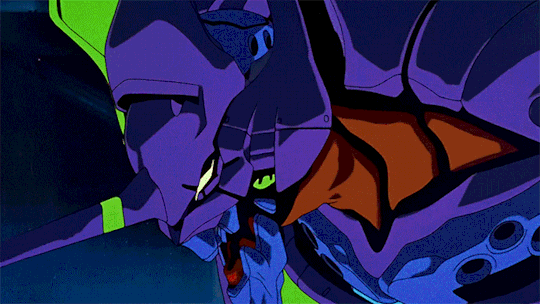
Anyway, the thing about the Evas is they are incredibly lithe. They run, rip and tear and swing heavy objects around in a way that’s both weighty and distinctly biological. Their bodies are extremely flexible compared to prior mechs (look at how much the spines bend in that Iso cut from EoE!), but not without hard, rigid components such as the shoulder towers. Their jaws are bestial but feature mechanical-like components like interlocking hexagonal teeth and jet-like vents. They are in short a fantastic design that blends biological and mechanical features.
The impact of Eva on just about everything can’t be overstated, but as far as robot design, well. There certainly were works that leaned on the precedent set by Eva, as for example RahXephon, which also treats robots as something spiritual, prone to popping into a blob of weird little bubbles just like in Eva.
There’s a great deal missing from this account. I am very focused on anime because I’ve watched a lot more anime than I’ve read manga or played games from this period. So I’m sure there’s major foundational works I’m missing here!
the 2000s
When did the West start to catch up? eh that’s subjective - David Cronenberg was way ahead of the game! - but specifically in the sense of robots with mechanical muscles, I think the major points in the timeline go a bit like this.
In 1999, there’s the Matrix, which leans heavily on anime. This features a similar ‘robot takeover’ premise to Terminator, but here it’s biomimetic robots modelled after squids, with clouds of constantly moving tentacles that sweep behind them. After making a cool half a billion dollars, the Wachowskis decided to pay all their favourite anime directors to make short films. I’m not going to comment on every part of the Animatrix, since most of it isn’t really relevant, but I will point to this horrifying cut by Takeshi Honda in The Second Renaissance in which a robot woman has her clothes torn and then skin bashed off by a mob. The framing, motion, her expression of abject terror, and the ‘reveal’ of her ‘true’ nature, all viscerally call to mind a trans bashing.
On the manga side, a big one to mention is Gantz, a gory nihilistic seinen manga which ran from 2000-2013. The characters in Gantz fight in special latex-like suits which take on the appearance of muscles while engaging superstrength, but can also sustain damage that causes them to drip fluids from ports located at the neck and become fatal to their wearer. Gantz was adapted to anime by Ichirō Itano in 2004, but I haven’t seen it so I can’t comment on any notable animation.
Cyborgs are a favourite subject of games, but in the 2000s, games are really pushing art direction and biopunk stuff is in. Half Life 2 (2004) has its spider-crab like Striders and dropships and so on. Oddworld: Abe’s Oddysee (1997) bases its whole concept around the sheer variety of weird creatures that would inhabit its dystopian factory. And I gotta give a shoutout to Septerra Core (1999) - in case one other person has played that lmao
At some point after 2005, Boston Dynamics became a viral sensation thanks to their robot BigDog. BigDog is just welded steel and hydraulics, but its lifelike hopping movement style definitely brought to mind the idea that the future of robots is going to be in biomimesis.
So, 2007, here comes Crysis to melt your PC! This is an FPS with the not-uncommon premise of being a supersoldier fighting (country America hates) and also aliens, but its gimmick was that you have a special exosuit that wraps around your body with artificial muscles, making you much stronger and manlier or whatever.
youtube
This is indicated by a visualisation that could be right out of a toothpaste ad, where tiny little balls drop into the character’s pores and somehow go straight into the bloodstream which is of course a void full of flying red blood cells. And so on. It sold the game, though! The ad there focuses almost entirely on the suit and not the character wearing it, who is basically an irrelevant soldier man. What it entailed in gameplay terms is that you have a mode switcher so you can have strength or armour or invisibility or whatever. But it’s cool military superscience, you see!
Anyway. Not like my preferred flavour of cyborg is any less stupid I guess x3
In the same year, Bayformers started. These films’ robots are honestly just visual noise, there’s so many moving metal shards going every which way that it’s next to impossible to discern any sort of underlying mechanical principle. A similar ‘overwhelming business’ visual effect would be applied the next year in Iron Man, kicking off the MCU. So mechanical muscles definitely weren’t the only expression of ‘hyper-advanced robot’ in Western visual media in the late 2000s.
I’m going to end my story with two more games: Horizon Zero Dawn and NieR Automata.
Horizon features a world inhabited by a large variety of robot animals, using the peak of AAA rendering techniques. The robots are designed to be biomimetic after both modern animals and prehistoric ones, and feature a combination of hard surfaces and softer biological muscles. For example, a robot horse:
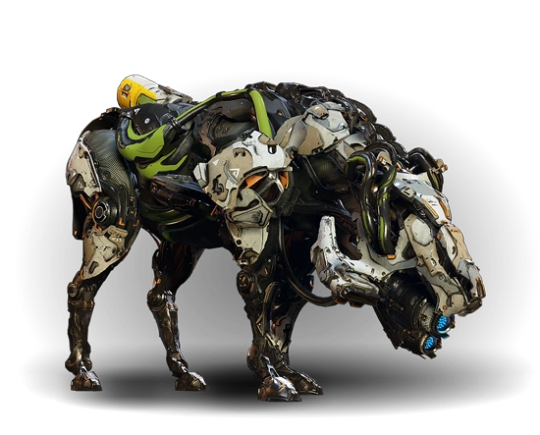
The discipline of making designs like these now has a name: it’s called ‘hard surface modelling’ and it involves boolean operations and bevels and other techniques designed to create a balance of hard edges on a surface against the smoother parts. The design language of Horizon says that the hard plates are white, the soft parts are very dark and may be patterned like a cloth texture, and there can be small colour accents here and there.
I think you can definitely see the influence of Boston Dynamics’s robots (and recent military tech in general) in these designs, iterated on through a decade and a half of increasingly intra-referential concept art. They are visually very busy designs, but there are a couple of recognisable features that draw attention by being inorganic, such as the cylindrical fuel tank at the back. Vitally, the silhouette is very readable.
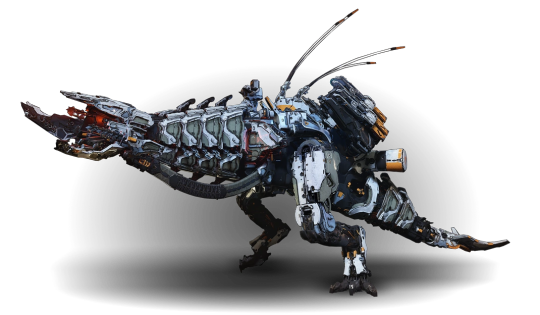
This robot T. rex for comparison serves as a world boss monster, and you can see it’s got a bunch of military looking attachments that look like radars and missile launchers and so on. As real tech evolved, so too did our idea of what a scary robot ought to look like.
So, that’s where this kind of design pattern has gone in mainstream games.
Now to finish, a brief comment on NieR Automata. Its designs draw hard on those of Ghost in the Shell. Visually it draws a strong contrast between the Machine Lifeforms, who have inorganic shapes (spheres and cylinders) and very visible and plausible mechanical joints, and the doll-like androids, who might as well be human (although A2 provides some contrast in an android who is damaged enough for the underlying materials to show through). The mechanical nature of the androids is communicated by the acrobatic way they move and the interface elements, and dead androids you find in the field - and later when they start losing arms and stuff, it’s a whole thing. But just like humans in Yoko Taro Games, they’re capable of dying in a puddle of blood.
(I guess if you take one thing from this post it’s that if you’re a robot, don’t expect to keep your arms.)
Robot muscles gives you a chance to give both the ‘anatomy porn’ of drawing something very precisely right, with the added bonus of giving you a reason to draw the muscles écorché, and the chance to make it weird and defamiliarised by splitting it with mechanical elements. In short... they look cool!
In this whole post I’ve basically not touched at all on illustration. I can point to a variety of illustrations of robot girls, but in terms of periodising them, I just don’t think I know enough. Though it’s safe to say that cyborg bodies in various states of construction or disrepair are now a mainstream of concept art - and that Ghost in the Shell is usually cited as an influence. I don’t know if robot muscles ever truly became the mainstream way to depict a robot, but it does feel like they’re increasingly common.
One artist I will briefly mention (besides sukabu), mostly bc I think they’re neat, is Haruyo Megurimu, who draws these very intricate designs of ‘necrotech’ which is sort of very biological robots extending out of human bodies - limbs extended on long spindly insectoid strands, jaws splitting open, that kinda thing. Can’t say who influenced them or anything but it’s a compelling extension of the idea into a particular corner of aesthetic space.
And that’s all I’ve got I think. There’s definitely big gaps like. More recent sci-movies. Western comics. Nevertheless, that’s an arc.
If you’ve read this far: thank you for indulging my autism.
800 notes
·
View notes
Text
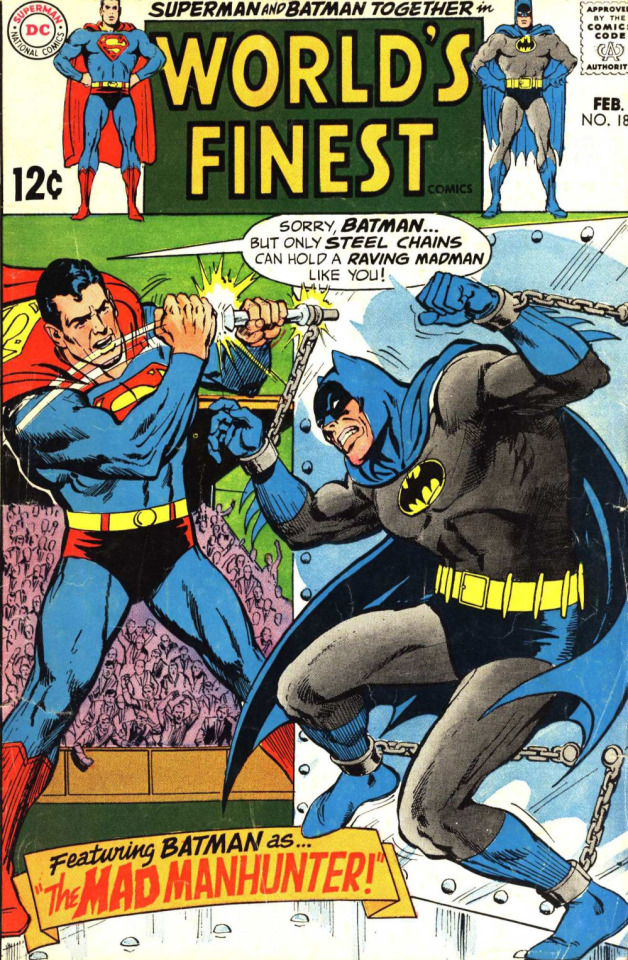

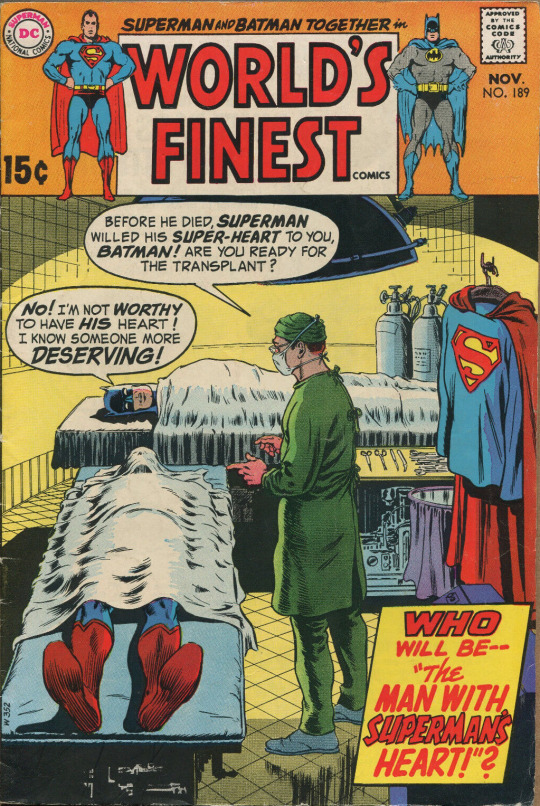
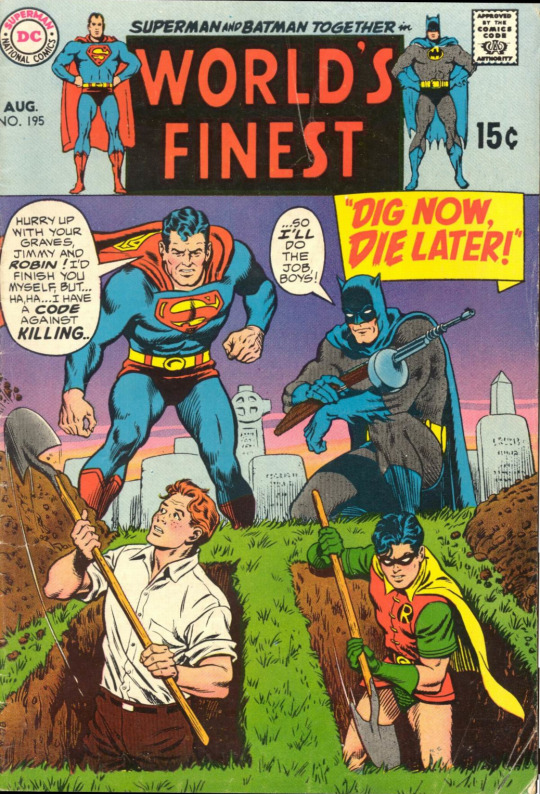
There are some things in DC's voluminous back catalog that they ought to properly reprint because they're good — gems of past eras. However, there are also some things they ought to properly reprint because they're delightfully stupid, like the Superman/Batman team-ups from WORLD'S FINEST COMICS. DC has actually reprinted all the stories from the '50s, through about 1961, but a lot of the '60s material has only been reprinted in the B&W SHOWCASE PRESENTS books, which is a shame.
The WORLD'S FINEST team-ups went through several distinct phases. Superman, Batman, and Robin had shared the covers of WORLD'S FINEST COMICS since 1941, but it wasn't until 1954 that shrinking page counts obliged them to actually share the lead feature. The '50s stories are pretty good of their time, with some lovely Dick Sprang art, and the presence of Superman meant the drift into science fiction was less jarring than in the contemporary Batman books. In 1964, editorial control of WORLD'S FINEST passed to Mort Weisinger and it became a Weisinger-era Superman book that happened to have Batman and Robin in it. Starting in 1967, though, things started to get stranger and stranger as Weisinger's stable of sci-fi veterans like Edmond Hamilton and Otto Binder gave way to Bob Kanigher, Cary Bates, and Bob Haney, who turned out some exceedingly weird material. Stories like the two-parter about Superman having died and willed his super-organs to various people (#189–190) aren't quite as ghoulish as the covers suggest, but their inexplicable weirdness is emblematic of the period.
For a little while in the early '70s, DC evicted Batman from the series, making WORLD'S FINEST a general-issue Superman team-up book. (DC reprinted those issues in trade paperback in 2020.) This apparently wasn't a big commercial success, but rather than immediately returning to the expected Superman/Batman format, WORLD'S FINEST began to feature the Super-Sons, the teenage sons of Superman and Batman in a hazily defined parallel reality — written by Bob Haney, whose stories consistently evoke the sensation of mild concussion. The "real" Superman and Batman also returned, although they had to alternate with their hypothetical future sons, appearing roughly every other issue through 1976. From 1976 to 1982, WORLD'S FINEST once again became an oversize anthology book, with a Superman/Batman main feature backed by a variety of other characters like Green Arrow and Hawkman. The stories in that period are not quite as ludicrous as the late '60s (although if you see Bob Haney's name in the credits, you know you're in for a wild ride), but even the soberer installments are consistently very silly, full of nonsense like Kryptonian lycanthropy and the return of some especially ridiculous older villains like the Gorilla Boss of Gotham City and Doctor Double-X.
It wasn't until issue #285 that Superman and Batman again had the book all to themselves. The late period dials back the zaniness and has mostly uninspired plots, but writers Doug Moench and David Anthony Kraft compensate with some eyebrow-raising and apparently deliberate "Superbat" ship-bait; my personal favorite is Kraft's "No Rest for Heroes!" (a short story in the back of WORLD'S FINEST #302), where Superman and Batman go to a dive bar in the middle of nowhere to talk about their relationship and Batman ends up throwing a knife at someone.
Very little of this stuff is actually good by any normal standard — although the 1964–1967 period is no more or less weird than any other Weisinger Silver Age Superman stories — and the artwork is only occasionally better than passable. However, it's so stupid and so ridiculous that it's consistently fun, in a way DC doesn't really do anymore, at least not on purpose. Assembling all the Superman/Batman stories (leaving the Super-Sons to their own TPB), omitting the various backup strips, and giving it decent color reproduction would make for a nice package, and the presence of Superman and Batman would make it more commercially viable than some of DC's more artistically worthy back catalog material. Low-hanging fruit, if you ask me.
#comics#world's finest comics#curt swan#neal adams#murphy anderson#superman#batman#robin#jimmy olsen#mort weisinger#cary bates#robert kanigher#bob haney#david anthony kraft#doug moench#superbat
164 notes
·
View notes